Palaeos: Main Glossary
The following, inevitably incomplete, introductory glossary of terms and concepts links to other topics discussed elsewhere on this site, as well as including general topics of interest such as well-known prehistoric animals. It still needs to be modified more by removing some more technical terms, and adding more common terms. Inevitably there is some duplication with other glossaries.
Some of the references and source material used in compiling this list include Wesley R. Elsberry's talk.origins jargon FAQ (mirror as convenient single document text file and William Hudson's more readable glossary of terms, and also more relevant as a general evolution and science glossary (Talk Origins emphasises good and bad arguments, geek culture, etc.); the US Geological Survey Glossary of Terms, the Understanding Evolution Glossary, the PBS evolution Glossary, as well as Wikipedia: evolutionary biology topics, and other Wikipedia pages on evolution and Creation–evolution controversy; the EvoWiki Encyclopedia (including Geology, Paleontology, Paleontologists, EvoWiki: History of science, although more topics need to be added or listed, and some of my (MAK) own interests and definitions. Where an entry is taken from a single reference, the source is given; sometimes where there it integrates a number of references none is. Due to constraints of time, I have not hyperlinked the entries, nor is this listing complete. In addition, because of limitations of time and energy, or perhaps just sheer laziness and apathy, I have for the most part only included on-line references, which are easier to copy and paste ;-)
A | B | C | D | E | F | G | H | I | J | K | L | M | N | O | P | Q | R | S | T | U | V | W | X | Y | Z
Abiotic evolution Non-biological evolution, for example mineral evolution, stellar evolution, etc.
Abiotic factors The non-biological environmental influences that affect organisms; for example, temperature, rainfall, and humidity.
Absolute dating A means of estimating the age of rocks with some degree of accuracy using measurements of radioactive isotopes.
Acanthodians A primitive group of Silurian to Permian jawed bony fishes, bearing bony spines in front of all but their caudal fins.
Acritarch microscopic organic structure from any of a number of organisms; common during the Proterozoic.
Age of Reptiles term found in popular books on evolutionary systematics for the Permian through to Cretaceous periods (but obviously originating with Victorian discoveries of "antediluvian monsters"), when reptiles (first mammal-like reptiles, then archosaurs and marine reptiles) were the dominant life on Earth. Paleontologist Edwin Colbert wrote a popular intelligent layperson book with the same title. The Age of Reptiles was followed by the Age of Mammals.
 |
| Age of Reptiles
mural by Rudolph Zallinger
|
The Age of Reptiles is also the title of a 110-foot (30 meter) mural painted by Rudolph Zallinger depicting the time from the Devonian to the Cretaceous and featuring dinosaurs and other prehistoric animals (His The Age of Mammals mural is similar and covers the Cenozoic). The fresco sits in the Yale Peabody Museum in New Haven, Connecticut, and was completed in 1947 after three years of work. The Age of Reptiles was at one time the largest painting in the world, and depicts a span of nearly 350 million years in Earth's history. Painted in the Renaissance fresco secco technique, The Age of Reptiles was an important cultural influence during the 1950s–60s, images of which are often found in earlier books on paleontology, and was also the model for dinosaur toys. Despite its somewhat outdated view of dinosaurs (presenting them as slow, sluggish creatures), The Age of Reptiles is still notable for its historical and artistic merit and as the largest natural history painting in the world. It has been an inspiration to many visitors including both Robert Bakker and Peter Dodson, who credit it with influencing them to become paleontologists. Dodson was nearly moved to tears upon first seeing it as a college senior.
Editor's note: In my own case (MAK), a photo of this mural in a book (I no longer remember which one) when I was still a young child (maybe 10 or so) exerted a huge influence on me, like a revelation, and for the first time gave me a visual appreciation of deep time in terms of succession and transformation of various forms of plant and animal life. To this day, this mural, along with a spindle diagram of vertebrate evolution in G.G. Well's Science of Life, have been the two central influences that determined the way I think about deep time and the evolution of life on Earth. I think of Palaeos as in many ways simply an extension, update (in keeping with more recent discoveries) and commentary on this magnificent work.
Algorithm In mathematics and computer science, an effective method (a procedure that reduces the solution of some class of problems to a series of rote steps that give a specific and correct answer)
expressed as a finite list of well-defined instructions for calculating a function. Algorithms are used for calculation, data processing, and automated reasoning.
Amino acid The molecular building blocks of proteins. The properties of a protein are determined by its particular amino acid sequence. There are 20 amino acids in the proteins of life on Earth.
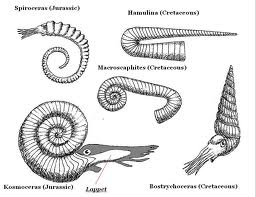 |
| Figure: selected ammonites
|
Ammonite A coiled, chambered fossil shell of a cephalopod mollusc of the extinct subclass Ammonoidea.
Amoeba A microscopic, single celled protozoan consisting of a naked mass of protoplasm. Once considered the simplest form of animal life, they are now known to consist of several distinct and unrelated groups of protists.
Amphibian A class of vertebrates that have to return to water to lay their eggs. They are often equally at home on land and in water, hence the name "amphibian", derived from the Greek terms ἀμφίς‚ (amphis, "on both sides") and βίος‚ (bios, "living"). Morphologically and ecologically diverse during the late Paleozoic era, including aquatic, semi-aquatic, and terrestrial newt, snake, crocodile, and frog analogues. The traditional term "amphibian" is disliked by cladists because it does not constitute a natural clade and so is considered phylogenetically meaningless. Hence instead terms like basal tetrapod or the names of individual clades and taxa (temnospondyls, lepidospondyls, Lissamphibia, etc), are used. Nevertheless, "amphibian" can still be used in a generic sense to refer to any non-amniotic tetrapod.
Amniote major tetrapod lade that reproduce by means of an external or internal egg in which the embryo or fetus is protected and nourished by several extensive membranes. Include reptiles, birds, and mammals. Middle Carboniferous to recent.
Ancient Astronaut theory new age meme advocated by Erich Von Däniken, according to which extraterrestrials were involved in, or are responsible for, human evolution. A secular form of intelligent design. Generally does not try to explain where the rest of life (or the aliens themselves, for that matter!) comes from. A more recent iteration can be found in Ridley Scott's movie Prometheus. Compare with panspermia.
Angiosperm plants that possess true flowers with seeds enclosed in an ovary.
Ankylosaur herbivourous armoured mostly Cretaceous "bird hipped" dinosaurs with rows of bony plates protecting the sides and back, and armed with either spikes along the sides or a bony club at the end of the trail
Anthropocene informal geochronological term that serves to mark the evidence and extent of human activities that have had a significant global impact on the Earth's ecosystems. Compare with Holocene.
Anthropocentrism, anthropocentric Centering on humans and considering or relating all other things to man; for example the biblical idea that only man has a divine soul, or the belief that humans are of greater moral worth than other species; the practice, conscious or otherwise, of regarding the existence and/or concerns of human beings as the central fact of the universe. Compare Ascent, Creationism, Teleology. Contrast biocentrism.
Archean the second of the four eons of the geological timescale, characterised by a reducing (non-oxygen) atmosphere and the earliest prokaryote life. It lasted from about 3.9 to 2.5 billion years ago.
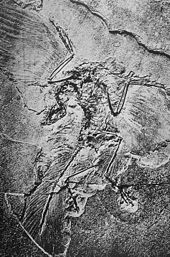 |
| 1880 photo of the Berlin Archaeopteryx specimen
From Vogt, C. 1880. "Archaeopteryx macrura, an Intermediate Form between Birds and Reptiles". Ibis 4:434-456.
|
Archaeopteryx the earliest and most primitive known bird, most of whose fossil remains were recovered in the 19th century, from the Jurassic Solnhofen limestone in Bavaria. Perfectly intermediate between reptile (or more correctly, theropod dinosaur) and modern bird, its discovery was powerful evidence for Darwinian evolution.
Arthropoda derived from the Greek terms ἄρθρον (arthron, "joint") and πόδα (poda, "foot"); it is a major phylum of segmented animals with an exoskeleton, includes trilobites, insects, spiders, crustacea, and others. An important component in marine and terrestrial ecosystems. Cambrian to recent.
ASCII phylogenetic tree As here defined, an ASCII phylogeny, or more correctly an ASCII phylogenetic tree, is a dendrogram or tree diagram which uses ASCII text format to draw supertrees. Also informally be referred to as ASCII cladograms.
Assemblage zone An aggregation of fossils in a body of sedimentary rock.
Australopithecus, australopithecine derived from the Latin terms austrī ("south wind") and -alis (an adjective-forming suffix) and the Greek term πίθηκος (pithēkos, "ape"); it is a hominid predecessor of Homo, known from the Plio-Pleistocene of Africa, first discovered by Raymond Dart. Mostly smaller than a modern human, walked erect, with a human-like body but ape-like skull, showing that brain size evolved late in evolution, rather than early, as the Piltdown forgery led early 20th century scientists to believe. The famous early hominid fossil "Lucy" is an example of an Australopithecine.
Astrobiology, also Exobiology is the study of the origin, evolution, distribution, and future of life in the universe. This interdisciplinary field uses physics, chemistry, astronomy, biology, molecular biology, ecology, planetary science, geography, and geology to investigate the possibility of life on other worlds and help recognize biospheres that might be different from the biosphere on Earth. It includes the search for habitable environments in our Solar System and habitable planets outside our Solar System, the search for evidence of prebiotic chemistry, laboratory and field research into the origins and early evolution of life on Earth, and studies of the potential for life to adapt to challenges on Earth and in outer space. Astrobiology addresses the question of whether life exists beyond Earth, and how humans can detect it if it does. The term exobiology is similar but more specific — it covers the search for life beyond Earth, and the effects of extraterrestrial environments on living things. I have here used these two terms as synonyms.
Autotroph an organism which makes its own food from inorganic materials, using sunlight or chemical reactions for energy.
Bakker, Robert T. popular figure in dinosaur paleontology, largely credited with the "dinosaur renaissance" of the late 1960s and 1970s.
Bacteria microscopic single-celled organism; the commonest and most ubiquitous form of life on Earth. Synonymous with prokaryote. Woese et al 1990 restrict the term "Bacteria" to Eubacteria only, and this practice has since been widely adopted, but in order to avoid confusing with the more general definition we have avoided following this course.
Basal Preferred cladistic substitute for "primitive", as it is felt the latter may carry false connotations of inferiority or a lack of complexity.
Bauplän basic morphological body plan, involving the shared structural homologies of derived taxa, generally defines phyla or other major groups of organisms.
Belemnite a Mesozoic to early Tertiary cephalopod mollusc with an internal cone-, bullet-, or cigar-shaped shell. In life a squid-like animal, along with their cousins the ammonites they were important members of the Mesozoic marine ecosystem.
Benthic Used to describe aquatic organisms that are bottom dwelling.
Benton, Michael J. British paleontologist, professor of vertebrate palaeontology in the Department of Earth Sciences at the University of Bristol and author of many papers and several popular science books, as well as the palaeontology textbook Vertebrate Palaeontology.
Berriasian geologic age of the earliest Cretaceous, spanning the time between 135 and 131 million years ago.
Big Five five mass extinctions identified by Jack Sepkoski and David M. Raup in a paper published in 1982. These are:
-
Ordovician–Silurian extinction event
-
Late Devonian extinction event.
-
Permian–Triassic, or End Permian extinction event, aka the Great Dying.
-
Triassic–Jurassic extinction event (apparently two, the End-Carnian and the End-Triassic, not as large as the others).
-
Cretaceous–Tertiary (K–T) extinction event.
Big History history not just on the human scale, but also Earth and cosmic history. In a sense, the Palaeos website is concerned with Big History. Compare Deep Time, Universe Story.
Bilateral symmetry Symmetry in only one plane, called the sagittal plane, that divides an organism into roughly mirror image halves. Contrast radial symmetry.
Binomial nomenclature Linnaean universal standard of biological scientific notation, according to which every species is given a distinct two-part name. The first part, think of it as like the surname, is the genus, which is capitalised, the second part the species, written completely in lower case, is like the given name. Both names are by convention written in italics.
Biocentrism Centered on life as a whole, rejecting the idea that man is the summit of creation, or has greater moral worth or ontological value than other species. Contrast anthropocentrism.
Biodiversity In biology, the degree of variety of the Earth's animal, plant, and microbial lineages within a given ecosystem, biome, or an entire planet. Used to describe species richness, ecosystem complexity, and genetic variation.
Biogeography the study of the distribution of organisms and species, past and present, and of diverse processes that underlie their distribution patterns.
Biome The total complex of biotic communities occupying and characterizing a particular area or zone, classified according to its climate and type of vegetation.
Biosphere life as a planetary phenomenon, the global ecosystem, the totality of life on Earth, or on other planets in the universe.
Biostratigraphy dating rock layers according to the fossils they contain. Provides information on the relative age of the rocks, in contrast to radiometric dating, which gives data for the absolute age. Also, more informally, using the fossil record in Deep Time to understanding the evolution of life. Evolutionary Systematics, which developed from paleontology, utilises biostratigraphy, whereas cladistics, which is based much more on neontology, totally rejects it in favour of morphological similarity alone, on the grounds that the fossil record is incomplete.
Biota The plants and animals of a specific region or time period.
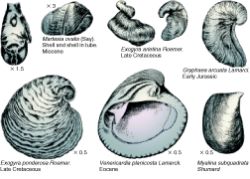 |
| A variety of fossil bivalves
after C. L. Fenton and M. A. Fenton, The Fossil Book, Doubleday, 1958. (original URL) |
Bivalve names any a mollusc that is a member of Class Bivalvia, a clade characterised by having two shells hinged together, as the oyster, clam, scallop, or mussel. The term is sometimes also used to refer to any animal with two halves to its shell such as an ostracod or brachiopod. Here bivalve is used to refer specifically to the molluscan class. In contrast to brachiopods, the plane of symmetry is primitively between the valves (the two shells), although many types, for example oysters, developed different sized valves. The second largest class of mollusc, after gastropods. Common as fossils, especially during the Mesozoic and Cenozoic, and these animals remain an important element in marine ecologies, especially in the littoral region.
Bony Fishes Fish of the class Osteichthyes, characterized by a skeleton composed of bone in addition to cartilage, gill covers, and an air bladder.
Brachiopod derived from the Greek terms βραχίων (brakhiōn, "arm") and πόδα (poda, "foot"); it names any member of a major phylum of marine organisms with bivalved shell, in contrast to molluscan bivalves the plane of symmetry is through the mid-line of the shell, not between the valves. Filter feeding by means of a specialised organ called a lophophore. Abundant during the Paleozoic (most especially from the Ordovician to the Devonian), where, along with corals, they make up the majority of invertebrate fossils. Less common in the Mesozoic, and even less frequent in the Cenozoic. Cambrian–Recent.
Brachiosaurus gigantic Late Jurassic to Early Cretaceous sauropod with sloping back and forearms longer than hindlimbs, include some of the largest land animals ever to walk the Earth. Originally applied to a number of such animals, there is a tendency now to include each species in a separate genus, as some of these animals differ in many details. However, dinosaur genera are certainly oversplit. During the mid Cretaceous, brachiosaurs were replaced by the equally huge titanosaurs.
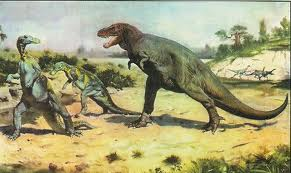 |
| Figure: Tyrannosaurus rex charges the "duck billed" herbivore Trachodon (later renamed Anatotitan and Edmontosaurus).
|
Bryozoa derived from the Greek terms βρύον (bruon, "moss") and ζῷα (zōa, "animal"); is a phylum of exclusively aquatic and mostly marine colonial organisms. At one time thought to be related to brachiopods because of the common possession of a lophophore, this is now considered the result of convergence. Ordovician–Recent.
Cambrian The earliest period of the Paleozoic era, spanning the time between 544 and 505 million years ago. Its name derives from Cambria, the Roman name for Wales, where rocks of this age were first studied.
Major diversification of life in the Cambrian Explosion. Numerous fossils; most modern animal phyla appear. First chordates appear, along with a number of extinct, problematic phyla. Reef-building Archaeocyatha abundant; then vanish. Trilobites, priapulid worms, sponges, inarticulate brachiopods, and many other animals numerous. Anomalocarids are giant predators, while many Ediacaran fauna die out. Prokaryotes, protists (e.g., forams), fungi and algae continue to present day. Gondwana emerges. Petermann Orogeny on the Australian Continent tapers off (550–535 Ma). Ross Orogeny in Antarctica. Adelaide Geosyncline (Delamerian Orogeny), majority of orogenic activity from 514–500 Ma. Lachlan Orogeny on Australian Continent, c. 540–440 Ma. Atmospheric CO2 content roughly 20–35 times present-day (Holocene) levels (6000 ppmv compared to today's 385 ppmv).
Cambrian explosion, Cambrian radiation The abrupt appearance of a diverse and highly derived fauna in the brief Tommotian and Atdabanian Stages of the Early Cambrian, one of the most, if not the most, dramatic evolutionary radiations in the history of life. Although that particular phrase only came into common usage in the early to mid 1970s, the event itself has long been recognized as a phenomenon demanding some accommodation from evolutionary theory. As early as 1859, Charles Darwin drew attention to the matter in Origin of Species, and it is probable he had considered the matter for many years prior to that.
Cartilaginous fishes Class Chondrichthyes; fish having a skeleton composed mostly of cartilage, as sharks and rays. Cartilage, aka gristle, is a firm, elastic, flexible type of connective tissue.
Cell The basic structural and functional unit of living organisms, differentiated into cytoplasm and nucleoplasm, which contains DNA, and enclosed by a cell membrane, which in the cells of plants, fungi, algae, and bacteria is surrounded by a cell wall.
Cenomanian geologic age of the earliest Late Cretaceous (middle Cretaceous), spanning the time between 95 and 91 million years ago.
Cenozoic derived from the Greek terms καινός (kainos, "new"), ζωή (zōē, "animal life") and -ικός (-ikos, an adjective-forming suffix); is the current of the three Phanerozoic eras in the geological timescale. It began 65.5 million years ago. The era when the modern continents formed, mammals and birds filled the ecological niches vacated by dinosaurs, and modern taxa of plants and invertebrates evolved. The later part of the Cenozoic was marked by a pronounced cooling, culminating in the Pleistocene ice age. Includes two periods, the Tertiary and Quaternary, and seven epochs, the Paleocene, Eocene, Oligocene, Miocene, Pliocene, Pleistocene, and Holocene.
Cephalopod derived from the Greek terms κεφαλή (kephalē, "head") and πόδα (poda, "foot"); names any member of Class Cephalopoda, a clade of highly intelligent molluscs, primitive types with shells, shells reduced and internal or lost altogether with more advanced members of the group. Shelled forms common in the fossil record. Includes nautiloids, ammonoids, belemnites, squid, octopi, and cuttlefish. Late Cambrian to Recent.
Chalk soft, earthy, fine-grained white to greyish limestone of marine origin. It is composed almost entirely of by shallow-water accumulations of coccoliths and other microscopic organisms and forms in a sea predominantly free from terrestrial sediment.
Chaotian a recently proposed addition to the geologic time scale in Goldblatt et al. 2010, it is an eon spanning the indeterminate amount of time between the collapse of the solar nebula and the collisional formation of the Earth–Moon system. The major subdivisions are the Eochaotian and Neochaotian eras with the start of the latter marked by the Sun's thermonuclear ignition.
Character In cladistics, any recognizable trait, feature, or property of an organism, used to reconstruct an evolutionary tree. Characters may be morphological, behavioral, physiological, or molecular. Character states the mutually exclusive conditions of a character (one of the possible alternative conditions of the character): for example, "present" and "absent" are two states of the character "hair" in mammals.
Chelicerate Arthropod subphylum characterized by have chelicera (a pair of pre-oral appendages), including arachnids (spiders, mites, etc), horseshoe crabs, scorpions and eurypterids ("sea scorpions").
Chordate organism having a notochord at some stage of development: a rigid cartilaginous rod in the back extending from anterior to posterior; includes the vertebrates along with several lesser known groups.
based on Curtis Loer & students
Chronospecies One or more species which continually changes from an ancestral form along an evolutionary scale. This sequence of alterations eventually produces a population which is physically, morphologically, and/or genetically distinct from the original ancestors. Throughout this change, there is only one species in the lineage at any point in time, as opposed to cases where divergent evolution produces contemporary species with a common ancestor. Relies on an extensive fossil record, since morphological changes accumulate over time and two very different organisms could be connected by a series of intermediaries. The related term paleospecies indicates an extinct species only identified with fossil material. To avoid unnecessary multiplication of terminology (and paleontology–neontological distinctions) these terms are here synonymised. For example, changes in the Permian lepospondyl amphibian Diplocaulus over time may imply a chronospecies (= paleospecies).
 |
| Simple cladogram classifying vertebrates according to their synapomorphies (shared unique characteristics). Most cladograms involve many hundreds of characteristics
|
Cladistics more correctly but less commonly known as Phylogenetic Systematics. Rigorous methodology first developed by Wili Hennig, which uses a logical empirical approach to reconstruct phylogeny, often represented in the form of a branching diagram, called a cladogram or tree. In contrast to evolutionary systematics, phylogenetic systematics collects character data only from the taxa being studied, and does not consider the inferred characters of ancestors, or the transformation from one species to another, nor does it consider deep time or the sequence of appearance of fossils to be of relevance, only shared morphological features. Cladistic methodology is very popular with vertebrate paleontologists and paleo geeks. In the march of paradigms, cladistics supplanted evolutionary systematics in the 1980s and 90s, but has since been pushed aside by molecular phylogeny, which ignores gross morphology altogether. Nowadays there is the tendency to combine both under the heading of phylogenetics
Cnidaria derived from the Greek term κνίδη (knidē, "nettle") and the Latin -aria (nominal form of an adjective-forming suffix); is a phylum of solitary or colonial, sessile or free-living, predatory organisms with specialized stinging cells called nematocytes (or cnidoblasts), and frequently having distinctive morphologies for asexual and sexual reproduction. Cnidarians include jellyfish, corals, hydrozoans and others. In older books the name coelenterate is used instead.
Coal swamp name given to the vast equatorial tropical forests and swamplands of the late Carboniferous, from which most modern black coal comes from (brown coal in contrast is Tertiary in age). Despite the name, coal swamps did not themselves contain any coal. Page with links to dioramas.
Coccoliths Microscopic structures of varying shape and size that are made of calcite, are secreted by calcareous nanoplankton, and are found in marine deposits from the Triassic period to the Recent. Coccoliths range in size from one to thirty-five micrometers in size.
They are found only in warm, low-latitude waters and hence useful for understanding ancient climates.
Co-evolution Evolution in two or more species, such as predator and its prey or a parasite and its host, in which evolutionary changes in one species influence the evolution of the other species. See also evolutionary arms race
Co-extinction the loss of one species due to the extinction of another; for example, the extinction of parasitic insects following the loss of their hosts. Co-extinction can also occur when a flowering plant loses its pollinator, or through the disruption of a food chain.
Common descent. This is the theory that every group of organisms descended from a common ancestor, and that all groups of organisms, including animals, plants, and microorganisms, ultimately go back to a single origin of life on earth.
Community Any grouping of populations of different organisms that live together in a particular environment (Allaby 1998), including plants, animals, micro-organisms.
Complexity A systemic characteristic that stands for a large number of densely connected parts and multiple levels of embeddedness and entanglement. Not to be confused with complicatedness, which denotes a situation or event that is not easy to understand, regardless of its degree of complexity.
Conodont derived from the Greek terms κῶνος (kōnos, "cone") and ὀδόντος‚ (odontos, "tooth"); designates microscopic tooth-shaped skeletal elements for a long time of unknown origin, now known to be the feeding apparatus of planktonic eel-like primitive/basal vertebrates . Important in biostratigraphy. Ordovician to Triassic. About 230 genera.
Continental drift the movement of the Earth's continents relative to each other. The hypothesis was proposed by Alfred Wegener in 1912, but it was not until an understanding of plate tectonics in the 1960s, that an actual geological explanation of that movement was found. There is considerable paleontological and geological evidence in favour of continental drift.
Convergent evolution, Convergence process in which two or more distinct lineages independently evolve similar characteristics of one another. In other words, there is an evolutionary convergence between two unrelated or only distantly related types. This often occurs because both lineages face similar environmental challenges and selective pressures. A form of homoplasy. Compare Parallel Evolution
Cope, Edward Drinker (1840–1897) important American paleontologist and comparative anatomist, whose competition with Othniel Charles Marsh for the discovery of new fossils became known as the "Bone Wars".
Coral Class Anthozoa, sessile Cnidaria, solitary or colonial polyp-like animals, may be soft-bodied (sea anemone) or secret a stony skeleton (this is the familiar coral). Often reef-building organisms. Include the Paleozoic Rugose and Tabulate corals, both common or very common as fossils in rocks of Ordovician to Permian age, and the Mesozoic to Recent Scleractinian corals.
Core A cylindrical section of rock, usually 2–4 inches in diameter and up to several feet long, that is the result of coring into the earth. Individual cores are brought to the surface for geologic examination and/or laboratory analysis.
Cosmology the study of the nature and structure of the universe, either from the standpoint of science (specifically physics and astrophysics), philosophy, esotericism, mythology, or religion. Generally a distinction is made cosmogony which refers to the study of origins of the Universe, but in practice the two are usually considered together. From a science perspective, cosmology and cosmogony include the Big Bang theory and hypotheses on the early history of the universe and the formation of galaxies and stars.
Counter-intuitive going against the most familiar or seemingly obvious interpretation. Science is often counter-intuitive.
Craton The stable portions of the continents that have escaped orogenic activity for the last 2 billion years. Made predominantly of granite and metamorphic rocks. compare orogen.
Creationism The belief in the universe and life on Earth as having a supernatural origin, creator, or designer. Assumes a static (non-evolving) universe. Based on the premise that science and religion are mutually incompatible and that only a literal belief in scripture is justified. Creationist arguments are easily refuted by science (see e.g. the Talk Origin archives). See also Intelligent Design. Creationists generally accept microevolution but not macroevolution.
Cretaceous The final period of the Mesozoic era, spanning the time between 145 and 65 million years ago. The name is derived from the Latin crÄ"ta ("chalk", "earth from Crete") and was first applied to extensive deposits of this age that form white cliffs along the English Channel between Great Britain and France.
Flowering plants proliferate, along with new types of insects. More modern teleost fish begin to appear. Ammonites, belemnites, rudist bivalves, echinoids and sponges all common. Many new types of dinosaurs (e.g. tyrannosaurs, titanosaurs, duck bills, and horned dinosaurs) evolve on land, as do Eusuchia (modern crocodilians); and mosasaurs and modern sharks appear in the sea. Primitive birds gradually replace pterosaurs. Monotremes, marsupials and placental mammals appear. Break up of Gondwana. Beginning of Laramide and Sevier Orogenies of the Rocky Mountains. Atmospheric CO2 close to present-day levels.
Crinoid sea lily, (Subphylum Crinozoa, Class Crinoidea) a type stalked and filter-feeding echinoderm that was very common during the Paleozoic, especially the early Carboniferous, and continues to flourish today, mostly in deep sea environments
Crustacean Subphylum Crustacea. Large group of mostly marine arthropods (although there are also some freshwater types and even a few terrestrial ones). Include shrimps, lobsters, crabs, barnacles, krill, ostracods, and terrestrial slaters and pillbugs. Morphologically distinct from other arthropods (hence given their own subphylum), but according to molecular phylogeny closely related to insects. Cambrian to recent.
Culture The result of individual learning processes that distinguish one social group of higher animals from another. In humans culture is the set of products and activities through which humans express themselves and become aware of themselves and the world around them.
 |
| Charles Darwin aged 51
|
Darwin, Charles: 19th-century naturalist and father of the theory of evolution. His landmark work, On the Origin of Species, published in 1859, presented a wealth of facts explaining how evolution occurs, via the mechanism he called "natural selection.
Dawkins, Richard English evolutionary biologist who has taught zoology and is the author of several books on evolution and science, including The Selfish Gene (1976) and The Blind Watchmaker (1986). He is known for his popularization of Darwinian ideas, as well as for original thinking on evolutionary theory. A committed atheist, he strongly argues for metaphysical naturalism.
Deep Time time that can only be thought of or measured in terms of geological processes (erosion, mountain building, glaciation, etc). Time that involves millions of years, as opposed to mere decades or centuries as in human history.
Deinonychus derived from the Greek terms δεινός‚ (deinos, "mighty") and ὄνυχος‚ (onukhos, "claw"); is a sickle-clawed feathered Middle Cretaceous theropod that was a bird "uncle" (close to the ancestry of birds, but living later than Archaeopteryx); a member of the family Dromaeosauridae.
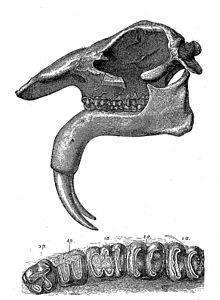 |
| Head and teeth of Deinotherium giganteum, from the Pliocene epoch.
from the book Kameno doba by Jovan Zujovic (1856-1936) |
Deinotherium derived from the Greek terms δεινός‚ (deinos, "mighty") and θηρίον (thērion, "beast"); is a huge prehistoric proboscidean, Miocene to Early Pleistocene, distinguished by no upper tusks, downward curving lower tusks, and a shorter trunk than elephants. One of the first types of prehistoric animal to be discovered.
Developmental biology study of the process by which organisms grow and develop. Modern developmental biology studies the genetic control of cell growth, differentiation and morphogenesis. Includes embryology (originally a more descriptive science until the 20th century). The related field of evolutionary developmental biology was formed largely in the 1990s and is a synthesis of findings from molecular developmental biology and evolutionary biology which considers the diversity of organismal form in an evolutionary context.
Devonian A period of the Paleozoic era, spanning the time between 410 and 360 million years ago. It is named after Devonshire, England, where rocks of this age were first studied.
First clubmosses, horsetails and ferns appear, as do the first seed-bearing plants (progymnosperms), first trees (the progymnosperm Archaeopteris), and first (wingless) insects. Strophomenid and atrypid brachiopod, rugose and tabulate corals, and crinoids are all abundant in the oceans. Goniatite ammonoids are plentiful, while squid-like coleoids arise. Trilobites and armoured agnathans decline, while jawed fishes (placoderms, lobe-finned and ray-finned fish, and early sharks) rule the seas. First amphibians still aquatic. "Old Red Continent" of Euramerica. Beginning of Acadian Orogeny for Anti-Atlas Mountains of North Africa, and Appalachian Mountains of North America, also the Antler, Variscan, and Tuhua Orogeny in New Zealand.
Dinoflagellate Small organisms with both plant-like and animal-like characteristics, in earlier taxonomies usually classified as algae (plants). The name is derived from the Greek δῖνος (dinos, "whirling") and the Latin flăgellum ("whip") due to the dinoflagellates' twirling motion and their whip-like flagella.
Dinosaur any of a diverse and successful group, Superorder Dinosauria, of mostly large to huge terrestrial archosaurian reptiles that dominated much of the Mesozoic, and gave rise to birds. Children and paleo geeks (who are kids who never grew up) seem to have a particular love of dinosaurs, because they represent all the things that make a creature cool: big, strange, and dead (extinct). All of which tends to overshadow the fact that these were among the most successful land animals that ever lived, their reign two and a half times longer than that of mammals. Because cladistics does not accept the validity of ancestral (paraphyletic) groups, the definition of dinosaur has been expanded to include their descendants, the birds. The Dinosauria were first described and named by Richard Owen. Three main monophyletic sub-groups: Theropoda, Sauropodomorpha, and Ornithischia.
Dinosaur renaissance term coined by paleontologist Robert T. Bakker (Bakker, 1975) referring to the academic and popular/lay paradigm shift in thinking about dinosaurs, of the late 1960s onwards, sparked by new discoveries and research indicating that dinosaurs may have been active and warm-blooded animals, rather than cold-blooded and sluggish as had been the prevailing view and description during the first half of the twentieth century. Championed by John Ostrom, who argued that birds evolved from coelurosaurian dinosaurs, by Ostrom's student Bakker, who argued that dinosaurs were warm-blooded not as gigantotherms but in the same way that mammals and birds are, and paleo-artist Greg Paul for example in his 1988 book on theropod dinosaurs. Led to a profound shift in thinking on nearly all aspects of dinosaur biology, including physiology, evolution, behaviour, ecology and extinction, as well as change in depictions of dinosaurs in popular culture (e.g. Jurassic Park, Walking with Dinosaurs), which have dominated all thinking about dinosaurs since.
Directionality (in evolution) as here defined, the premise that evolution begins with simple or primitive structures or forms of life and moves to greater complexity or perfection; hence some forms of life are more complex, advanced, or evolved relative to others. Whilst the emergence of complexity in the universe is a self-evident fact, philosophers and scientists are divided over whether evolution itself is directional.
DNA Deoxyribonucleic acid, the molecule that contains genetic information.
Duck-billed dinosaur common name for hadrosaurs, a type of ornithopod dinosaur that were the most common large herbivores of the late Cretaceous northern hemisphere (in the southern hemisphere sauropods still predominated). So called because in some advanced forms such as Edmontosaurus the front of skull and jaws are wide and flattened, superficially resembling a duck's bill. Prior to the dinosaur renaissance, artists drew them like huge ducks. It is now known that in life the sides of the jaws were covered by cheeks, and looked nothing like a duck's bill.
Early In the geological timescale, the chronological equivalent to Lower. Often refers to a subdivision or epoch of a period, especially when the period is divided into three; e.g. "Early Jurassic".
Ecdysozoa Clade of animals that grow by periodically moulting or shedding their skin or exoskeleton (timed by steroid hormone signals); share a unique pattern of HOX genes, lack cilia; have separate sexes that copulate to achieve egg fertilization.
Echinoderm derived from the Greek terms ἐχῖνος‚ (ekhinos, "hedgehog, sea urchin") and δέρμα (derma, "skin"); names any member of Phylum Echinodermata; a large group of primarily pentamerally radially symmetrical exclusively marine metazoans with internal calcite skeletons and hydrostatic vascular system. Includes crinoids (sea lilies), echinoids (sea urchins, sand dollars, sea biscuits), holothurians (sea cucumbers), asteroids (starfish), ophiuroids (brittle star), and many exclusively Paleozoic groups such as blastoids, edrioasteroids, carpoids, and others.
Echinoid Subphylum Echinozoa, Class Echinoidea. Sea urchins and their relatives. Echinoderms with spherical or flattened bodies, often protected by long spines, like starfish they move about on tube feet. Very common as fossils, especially in the Cretaceous and Tertiary. Ordovician–Recent (rare prior to the Jurassic).
Ecosystem A discrete unit, or community of organisms and their physical environment (living and non-living parts), that interact to form a stable system.
Ectotherm derived from the Greek terms ἐκτός‚ (ektos, "outside") and θέρμη (thermē, "heat"), colloquially intended as "cold blooded"; is an animal that regulates body temperature through external means; e.g. basking in the sun to become warmer, or sitting in the shade to become cooler.
Ediacaran most recent period of the Proterozoic era, characterised by the appearance of both enigmatic Vendobionta and trace fossils that seem to pertain to more conventional organisms. The term Ediacaran was replaced for a while by Vendian, but now it seems that Ediacaran is back in fashion.
Ediacaran biota enigmatic life forms from the Ediacaran period; the first large to appear. Their affinities remain highly controversial; they have been interpreted as the first representatives of current animal phyla (Cnidaria, Annelida, Arthropoda, etc), as sister group to all Metazoa more derived than sponges, as a totally distinct kingdom (Vendobionta, Vendozoa), and even as marine fungi and giant Rhizarian protists. Each hypothesis has advantages and disadvantages going for it.
Electrophoresis The method of distinguishing entities according to their motility in an electric field. In evolutionary biology, it has been mainly used to distinguish different forms of proteins. The electrophoretic motility of a molecule is influenced by its size and electric charge.
Embryo An early stage of animal development that begins after division of the zygote (the earliest stage, in which joined egg and sperm have not yet divided).
Embryology study of embryogenesis, the development of animals and plants from fertilization to birth/hatching.
Emergence also Spontaneous order, self-organization. The appearance of novel characteristics exhibited on the level of the whole ensemble, but not by the components in isolation.
Strong emergence is a type of emergence in which the emergent property is irreducible to its individual constituents. See also Evolutionary directionality.
Empiricism understanding the natural world by means of verifiable observation via the senses and scientific instruments; an essential component of scientific method and naturalism in general.
Endotherm derived from the Greek terms ἔνδον (endon, "within") and θέρμη (thermē, "heat"), colloquially intended as "warm blooded"; is an animal that regulates and maintains a constant body temperature and can generate internal heat for maximal metabolic efficiency, regardless of external (environmental, ambient) temperature.
Endosymbiosis A relationship in which one organism lives inside another, to the mutual benefit of both (these are called endosymbionts). Examples are nitrogen-fixing bacteria (called rhizobia) which live in root nodules on legume roots, single-celled algae inside reef-building corals, and bacterial endosymbionts that provide essential nutrients to about 10%–15% of insects. It is generally accepted that early in the evolutionary history of Eukarya, eukaryote cells engulfed bacteria, forming a symbiotic relationship, which became so mutually interdependent, that they behaved as a single organism; these include mitochondria and chloroplasts.
Eocene An epoch of the early Tertiary period, spanning the time between 55.5 and 33.7 million years ago. Its name is derived from the Greek words ἠώς (eos, "dawn") and καινός (kainos, "new"). It was a period of global greenhouse climate and lush forests, in which small to large archaic mammals, large reptiles, and giant flightless birds all flourished.
Moderate, cooling climate. Archaic mammals (e.g. Creodonts, Condylarths, Uintatheres, etc) flourish and continue to develop during the epoch. Appearance of several "modern" mammal families. Primitive whales diversify. First grasses. Reglaciation of Antarctica and formation of its ice cap; Azolla event triggers ice age, and the Icehouse Earth climate that would follow it to this day, from the settlement and decay of seafloor algae drawing in massive amounts of atmospheric carbon dioxide, lowering it from 3800 ppmv down to 650 ppmv. End of Laramide and Sevier Orogenies of the Rocky Mountains in North America. Orogeny of the Alps in Europe begins. Hellenic Orogeny begins in Greece and Aegean Sea.
Epoch A division of the geologic time shorter than a period. Epochs are further divided into several ages. Generally, the geological timescale and the history of life is described in terms of periods, but in the case of the 65 million year long Cenozoic era, epoches are used instead (Paleocene, Eocene, etc). With most earlier periods, epoches are often equivalent to the Early, Middle, and Late part of the period.
Erosion The transportation of material by a mobile agent, i.e., water, wind or ice.
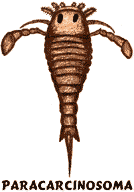 |
| The eurypterid Paracarcinosoma
|
Eubacteria the majority of extant bacteria; one of the three domains of life on Earth, prokaryotes that are metabolically and morphologically distinct from Archaea. Woese et al 1990 replaced "Eubacteria" with "Bacteria " as the taxon name; in order to avoid ambiguity we have avoided following this course.
Eukarya, eukaryote an organism whose cells contain complex structures enclosed within membranes (called organelles), and in which genetic material is contained within a nucleus, in contrast to prokaryotes. Generally reproduce through sexual rather than asexual means. Include all living organisms except bacteria
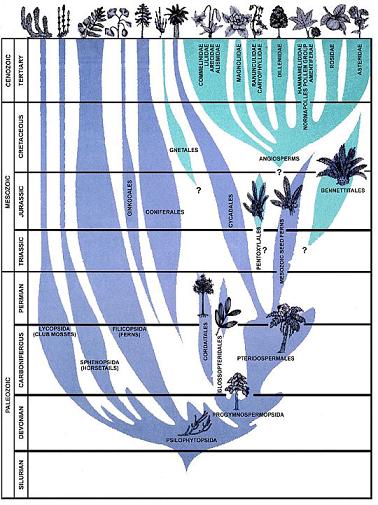 |
| Evolution of Plants. This Evolutionary systematics spindle diagram plots generic diversity (width) against time (vertical axis). In contrast to cladistics, the tree is rooted in ancestral groups and paraphyletic taxa. Angiosperms are related forms are shown in turquoise, gymnosperms in darker blue.
Appeared in a special Scientific American issue devoted to the evolution of life (ed. note: need to find citation).
|
Evo-Devo the informal name for Evolutionary developmental biology, a new branch of evolutionary studies that compares the developmental processes of different organisms to determine the ancestral relationship between them, and to discover how developmental processes evolved; incorporating insights from genetics, embryology and microbiology. It addresses the origin and evolution of embryonic development; how modifications of development and developmental processes lead to the production of novel features, such as the evolution of feathers in birds and the shell in turtles; the role of developmental plasticity in evolution; how ecology impacts in development and evolutionary change; and the developmental basis of homoplasy and homology. Answers many problems regarding the origin of new structures, and early development, raised by Creationism (e.g. the evolution of feathers in reptilian ancestors), Intelligent Design, and Vitalism.
Extremophile an organism that favours extreme conditions (relative to what is optimal to most life on Earth), such as very high or very low temperature, or lack of oxygen. Most life in the universe would almost certainly be extremophile.
Feathered dinosaur any of a large number of feathered, bird-like theropod dinosaurs that represent transitional stages between "ordinary" dinosaurs and birds. The discovery of numerous fossils of dinosaur skeletons complete with feathers, in China, and the realisation (thanks to the dinosaur renaissance) that even many other dinosaurs thought to naked and scaly actually had feathers and a bird-like physiology, provide proof that birds are descended from (in cladistic-speak, are a derived clade of) theropod dinosaurs.
Fish Generally, the lower vertebrates, a taxonomically meaningless assemblage of vertebrates defined only by their non-tetrapod nature.
Food chain a group of organisms interrelated by the fact that each member of the group feeds upon on the one below it. Wikipedia glossary
Food web a set of interconnected food chains by which energy and materials circulate within an ecosystem. Wikipedia glossary
 |
| Nummulitid foraminiferans from the Eocene near Al Ain, United Arab Emirates. Microspheric and megalospheric specimens shown. Scale in mm.
|
Foraminifera Amoeboid protozoans traditionally included under the subclass Sarcodina, order Foraminifera, but more recently reclassified as Rhizaria. They have a test (shell) of one to many chambers composed of secreted calcite or agglutinated particles. They have a comprehensive fossil record, and are very important in stratigraphy.
Fossil mineralized or otherwise preserved remains or traces (such as footprints) or impressions of animals, plants, and other organisms.
Evidence of past life on earth. Can include the preserved hard and soft parts of plants and animals, tracks and burrows, whole organisms preserved intact in amber or tar, and fossilized dung. Any evidence of life constitutes a fossil.
Fossil record the history of life on Earth through geological time, as preserved through fossil remains in sedimentary rock (sometimes referred to poetically in older books as the record of the rocks). Also the fossil history of any particular group
Fossilization All the processes that involve the burial of a plant or animal in sediment and the eventual preservation of all, part, or a trace of it.
Gametes The specialized cells produced by organisms for sexual reproduction. In isogamous species, the gametes produced by the sexes are of equal size; in anisogamous species, the gametes are of different sizes (with the producers of smaller gametes considered as male). In most metazoan animals, gametes are produced by meiosis and are haploid.
Gastrulation stage in animal development following cleavage characterized by extensive cell movement and rearrangement to form a "three-layered" embryo of ectoderm, mesoderm and endoderm.
Gauthier, Jacques American vertebrate paleontologist, comparative morphologist, and systematist, and one of the founders of the use of cladistics in biology and paleontology.
Gene The fundamental physical and functional unit of heredity which carries information from generation to the next.
Genetic algorithms Computational systems based upon an implementation of natural selection as an algorithm for classification or optimization.
Genetic drift Random changes in the frequency of genes in the population that are not due to selective pressure. This may occur because the different genotypes do not have a noticeable effect on the relative fitness of individuals (such as different mitochondrial haplotypes), or selection may not be strong enough to affect transmission of the genotype (for instance, on a recently-colonised island without predators). Genetic drift is a factor in neutral evolution. The significance of genetic drift in evolution is uncertain. In a large population, most of the factors affected by genetic drift will be minor, and drift is probably not significant over the population as a whole. However, in a small, isolated population drift may have a significant effect on the makeup of the population.
Genetics The branch of science which deals with elucidating the attributes and mechanisms of heredity in living systems. On Earth, this involves research into RNA and DNA.
Genome complete haploid complement of DNA (including all genes) from the chromosomes of the nucleus of an organism.
Genus In the Linnaean classification the taxonomic rank between family or tribe and species, and used to define group of closely related organisms that differ in only very minor ways. In the Linnaean system of binomial nomenclature, the genus is written in italics, with a capital letter, in front of the species name, or on its own. e.g. with Tyrannosaurus rex, the name Tyrannosaurus is the genus, and T. rex (no hyphen!) is the species. Used in evolutionary systematics; in cladistic classification every genus is only allowed two species (because of excessive formalism regarding cladogenesis), and Linnaean genera are always oversplit and new names created, resulting in much taxonomic confusion (for example in paleontology the established dinosaur genus Iguanodon has been split into about a dozen different monospecific genera (link). See also the discussion at Sauropod Vertebra Picture of the Week. It may be that the Phylocode will discard binomial nomenclature altogether (although there is obvious resistance to this) .
Geochemistry The science that deals with chemical changes in and composition of the earth's crust.
Geologic(al) timescale Standardised system of chronological measurement and dating, first developed during the early 19th century and revised ever since, which relates stratigraphy to time. It is used by geologists, paleontologists and other scientists to describe the timing of events that occurred during the history of the Earth, for example the age of particular rock strata, mountain building, or evolutionary radiation. The entire geological timescale consists of four eons, each divided into a number of eras. Each era is in turn divided into periods. Periods are further divided into epochs, which in turn are divided into ages. The regulatory scientific body that deals with this subject, the International Commission on Stratigraphy, uses an arbitrary colour code which nevertheless allows us to make Palaeos very colourful. The basic geological table is shown below; in keeping with stratigraphic and geological formalism, the oldest eras are at the bottom, the youngest at the top.
Phanerozoic PH |
Cenozoic CZ |
Neogene N |
23.0– |
Paleogene E |
65.5–23.0 |
Mesozoic MZ |
Cretaceous K |
146–65.5 |
Jurassic J |
200–146 |
Triassic T |
251–200 |
Paleozoic PZ |
Permian P |
299–251 |
Carboniferous C |
359–299 |
Devonian D |
416–359 |
Silurian S |
444–416 |
Ordovician O |
488–444 |
Cambrian Є |
542–488 |
Proterozoic PR |
2500–542 |
Archean AR |
3800–2500 |
Hadean HA* |
3850–4500 |
Chaotian CH* |
–4500 |
Geology The science that deals with the study of the planet Earth—the materials of which it is made, the processes that act to change these materials from one form to another, and the history recorded by these materials; the forces acting to deform the outer layers of the Earth and create ocean basins and continents; the processes that modify the Earth's surface; the application of geologic knowledge to the search for useful materials and the understanding of the relationship of geologic processes to people.
Physical Geology includes processes that affect the earth's internal and external structure, composition and other natural functions. Historical Geology is the study of Earth history and the evolution of life on earth, especially the past life forms that are preserved as fossils.
J. Wittstrom, Wikiversity
Glaciation The formation, advance and retreat of glaciers and the results of these activities.
Gondwana The southern land mass derived from the supercontinent of Pangea, which continued until its break-up during the Cretaceous and early Tertiary. It comprised of Antarctica, Africa, South America, Australia and India. The term is also used to describe these same continents when connected as a supercontinent in the Paleozoic, prior to Pangea. Gondwana means "Land of the Gonds" (a tribe from the Indian subcontinent). Note, the popular term Gondwanaland is therefore redundant.
 |
| Inostrancevia, a large gorgonopsid
|
Graptolite derived from the Greek terms γραπτός (graptos, "written") and λίθος (lithos, "stone"); are mostly planktonic, Paleozoic, colonial hemichordates with a chitinous skeleton (periderm), commonly preserved as carbon films in black shales, common during the Ordovician, Silurian, and early Devonian, important as index fossils 240 genera are known.
Great chain of being term coined by historian of ideas Arthur O. Lovejoy for the historical idea that all beings constitute a continuous series of forms an unbroken gradation from the Absolute (later, God) down through intermediate spiritual and material stages to formless matter. The premise was developed by Greek philosophers such as Plato (transcendent ideas), Aristotle (scala naturae), and Plotinus. In the Middle Ages it was the basis for both scholastic theology (ranking all of creation from dirt through to humans to angels) and feudal social stratification; it formed a central element in the Elizabethan understanding of the world still evident in Shakespeare's plays. It continued through 17th, 18th and 19th century Europe and North America, in an understanding of the universe as the highest good, complete and full (Lovejoy refers to this belief as "the Principle of Plenitude") in which every species of being has its perfect place and no species can ever become extinct (to do so would result in a gap in God's creation), and understanding this harmonious linear order of nature as a product of God's benign creative activity was a meaningful pursuit. From the end of the 18th century, with the "temporalization of the great chain of being" the meme persisted in evolutionary form (now as ascent rather than descent) through 19th century German Idealism and Naturphilosophie. Despite the rise of Darwinian evolution and a branching tree of life, the idea of a single line of ascent continued through mid 19th to early 20th century ideas of sociological evolution and social darwinism, and early to mid 20th century psychology and the meme is still strongly held (see for example March of Progress.
Guild Group of organisms having a similar morphology, and exploiting the same food resources, living the same life-style and in the same environment, but which are not necessary related. Because no two types of organisms can occupy the same ecological niche (one will inevitably outcompete the other, and push it aside), comparable guilds have to be separated by geographical or chronological distance. A good example of the same guild is the modern crocodile and the phytosaurian thecodont (Parasuchia) of the late Triassic. Both are astonishingly similar in size, appearance, and life-style, and indeed modern crocodiles only appeared after the phytosaurs had become extinct. But they are only distantly related (both are archosaurian reptiles, but their common ancestor lived millions of years before the first phytosaur appeared).
Gymnosperm derived from the Greek terms γυμνός (gumnos, "naked") and σπέρμα (sperma, "seed") due the unenclosed condition of their seeds (called ovules in their unfertilized state). Their naked condition stands in contrast to the seeds or ovules of flowering plants (angiosperms) which are enclosed during pollination. Includes conifers, cycads, Ginkgo, Gnetales, and extinct groups such as "seed ferns".
Habitat The environment, including physical and biotic conditions, where a plant or an animal usually occurs, physical conditions that surround a species or population
Hadean First of the four eons of the geological timescale, the earliest subdivision of the Precambrian, spanning the time between the formation of the Earth, about 4.5 billion years ago, and the start of the Archaean era, 3.8 billion years ago. This interval predates the period of true geologic time since no rocks of this age are known on Earth, with the exception of a few meteorites. . Except possibly for the very end of the Hadean, conditions were too harsh to support life (hence the name, after the underworld of Greek mythology). .
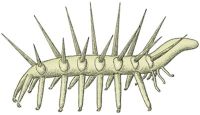 |
| Hallucigenia
illustration from Harold L. Levin, The Earth through Time
|
Hallucigenia A Cambrian lobopod (proto-arthropod) known from the Burgess Shale, and related to the modern Peripatus. When fossils were first discovered they were reconstructed upside down, resulting in a truly bizarre creature (hence the name). It was later shown that the stilt like "legs" were actually protective spines, and the row of "mouths" or feeding tubes along the back were in fact legs. .
Haploid having only half the normal complement of chromosomes.
Haeckel, Ernst (1834–1919) eminent German zoologist, naturalist, philosopher, physician, professor of comparative anatomy and artist who discovered, described and named thousands of new species, mapped a genealogical tree relating all life forms, and coined many terms in biology, including anthropogeny, ecology, phylum, phylogeny, and the kingdom Protista. His chief interests lay in evolution and life development processes in general, including development of nonrandom form.
Heredity the passing of traits to offspring (from its parent or ancestors). Through heredity, variations exhibited by individuals can accumulate and cause some species to evolve.
Hiatus A gap or interruption in the continuity of the geologic record either because the record was never formed or because it was destroyed by erosion. It represents the time interval spanned by an unconformity.
Higher In biology, an informal, "great chain of being" like term for more developed representatives of a particular taxon or lineage, e.g. "the higher primates". Terms like "ascent", "lower" and "higher", and "primitive" and "advanced" are discouraged by phylogeneticists because they impose subjective value judgments on the natural world.
Holism A non-reductionist descriptive and investigative strategy for generating explanatory principles of whole systems. Attention is focused on the emergent properties of the whole rather than on the reductionist behavior of the isolated parts. The approach typically involves and generates empathetic, experiential, and intuitive understanding, not merely analytic understanding, since by the definition of the approach, these forms are not truly separable.
Holocene An epoch of the Quaternary period, spanning the time from the end of the Pleistocene (10,000 years ago) to the present. The most recent period of geologic history, which extends from 10,000 years ago to the present. It is named after the Greek words ὅλος (holos, "entire") and καινός (kainos, "new"). See also Anthropocene.
The last glacial period ends; rise of human civilization. Quaternary Ice Age recedes, and the current interglacial begins. Younger Dryas cold spell occurs, Sahara forms from savannah, and agriculture begins, allowing humans to build cities. Paleolithic/Neolithic (Stone Age) cultures begin around 10000 BC, giving way to Copper Age (3500 BC) and Bronze Age (2500 BC). Cultures continue to grow in complexity and technical advancement through the Iron Age (1200 BC), giving rise to many pre-historic cultures throughout the world, eventually leading into Classical Antiquity, such as the Roman Empire and even to the Middle Ages and present day. Little Ice Age (stadial) causes brief cooling in Northern Hemisphere from 1400 to 1850. Also refer to the List of archaeological periods for clarification on early cultures and ages. Mount Tambora erupts in 1815, causing the Year Without a Summer (1816) in Europe and North America from a volcanic winter. Following the Industrial Revolution, Atmospheric CO2 levels rise from around 280 parts per million volume (ppmv) to the current level of 390 ppmv, due to anthropogenic emissions, very likely causing global warming and climate change.
Homeobox genes "Homeobox genes" are genes that contain "homeoboxes" ( relatively short sequences of DNA which play a central role in controlling body development), and can regulate the expression of other genes. There are at least 24 homeobox genes, some but not all of which are also homeotic in their effect. In general, "homeotic" genes are genes that control the identity of body parts. They are active in the early stages of embryonic development of organisms. Some, but not all, homeotic genes are homeobox genes. "Hox" genes are a subgroup of homeotic homeobox genes that determine positional cell differentiation and development. They lay out the head to tail body pattern in very early embryos. The Hox genes are very ancient and widely shared among bilateral animals. After the head to tail pattern is established, homeotic genes direct the developmental fates of particular groups of cells.
Homeostasis the property by which a system, especially a living organism, regulates its internal environment so as to maintain a stable, constant condition. According to James Lovelock, the planet Earth as a whole is homeostatic system (Gaia Hypothesis).
Homology/homologous structure a character shared by a set of species and present in inherited, with or without modification, from their common ancestor. For example, the bones in a bat's wing, a dog's front leg, and a human arm, are the same, although modified to serve different functions (see following diagram). Contrast with homoplasious.
Homoplasy Features that are similar but have an independent (or convergent) evolutionary origin, the opposite of homology; for example the streamlined shape and dorsal fin of a shark, ichthyosaur, and dolphin (ichthyosaurs and dolphins descended from land animals), or the wing of a pterosaur, bird, and bat (each evolved from distinct flightless ancestors).
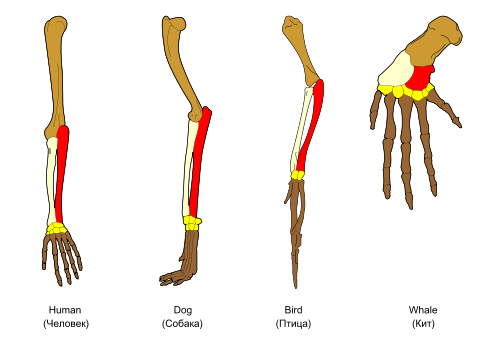
|
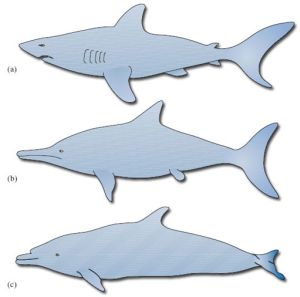 |
| The principle of homology: the common derivation (shown by colors) of the various bones in the forelimbs of a human, dog, bird, and whale. All four descended from a common ancestor (a basal amniote) who likewise had that particular type of forelimb.
from Wikipedia under Creative Commons/Public Domain. |
The streamlined bodies of (a) a shark, (b) an ichthyosaur and (c) a dolphin, an example of homoplasy. Despite the superficial similarity, each descended from very different ancestors; the shark from an earlier fish-like form, the ichthyosaur from a diapsid reptile of lizard-like appearance, and the dolphin from a somewhat dog like ungulate.
|
Hopeful monster termed coined by the German-born geneticist Richard Goldschmidt, who thought that small gradual changes could not bridge the divide between microevolution and macroevolution. In The Material Basis of Evolution (1940), Goldschmidt wrote "the change from species to species is not a change involving more and more additional atomistic changes, but a complete change of the primary pattern or reaction system into a new one, which afterwards may again produce intraspecific variation by micromutation." His thesis however was universally rejected and has been widely ridiculed within the biological community, which favored the neo-Darwinian explanations of R.A. Fisher, J. B. S. Haldane and Sewall Wright.
Host organism that serves as a habitat for another organism. A host may provide nutrition for a parasite, alternatively with mutualism the host benefits.
Hox genes A particular subgroup of homeobox genes that function to pattern the axis of an organism's body and determine where limbs and other body segments will grow as the embryo develops.
Hybrid an offspring resulting from cross-breeding between two different species.
Hydrogeology The science that deals with subsurface waters and geologic aspects of surface waters.
Ice Age period of earth history subject to lowered temperatures and high and medium latitude glaciation. There have been a number of ice ages in the Earth's history, of which the Pleistocene ice age was only the most recent. See also snowball earth.
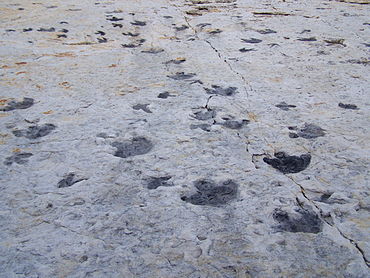 |
| Dinosaur footprints, preserved at Dinosaur Ridge, Morrison Formation (late Jurassic), Colorado
|
Ichnology branch of paleontology that deals with traces of organismal behavior, such as burrows and footprints.
Ichnotaxon defined by the International Code of Zoological Nomenclature as "a taxon based on the fossilized work of an organism". Ichnotaxa are names used to identify and distinguish morphologically distinctive ichnofossils, more commonly known as trace fossils. They are assigned genus and species ranks by ichnologists, much like organisms in Linnaean taxonomy. These are known as ichnogenera and ichnospecies, respectively. Ichnotaxa include trace fossils such as burrows, borings and etchings, tracks and trackways, coprolites, gastroliths, regurgitaliths, nests, leaf mines, bite and gnaw structures, secretions modified by organismal activity, such as cocoons, pupal cases, spider webs, embedment structures and plant galls.
Ichthyosaur group of mesozoic marine reptiles (Order Ichthyosauria / Ichthyopterygia) characterised by superficially dolphin-like appearance. The largest (Shonisaurus) grew to the size of whales.
Inheritance of acquired characteristics theory proposed by Jean Baptiste Lamarck, according to whom evolution occurs through the inheritance of traits or abilities an organism acquires in life. For example, the ancestral giraffe stretched its neck to reach the leaves of trees, and as a result passed on a slightly longer neck and legs to its offspring. Also referred to as the "use–disuse theory." Despited being rejected by Weismannian Neo-Darwinism, Lamarckism remained popular well into the early twentieth century, especially in France, but was supplanted by the synthesis of Darwinian and Mendelian theory.
Intelligence difficult to define quality associated with developed consciousness. Considered to include the abilities for abstract thought, understanding, communication, reasoning, learning, planning, emotional intelligence and problem solving. Intelligence is most widely studied in humans, but has also been observed in animals and plants. Artificial intelligence is the intelligence of machines or the simulation of intelligence in machines.
Intelligent design is the proposition that "certain features of the universe and of living things are best explained by an intelligent cause, not an undirected process such as natural selection." Usually a form of creationism restated in non-religious terms, retaining the idea of deity while seeking to embrace scientific method, although there are also non-religious versions of intelligent design, such as the "ancient astronaut" and panspermia memes.
International Code of Zoological Nomenclature widely accepted convention in zoology that rules the formal scientific naming of organisms treated as animals. The rules principally regulate:
-
how names are correctly established in the frame of binomial nomenclature,
-
which name has to be used in case of conflicts among various names,
-
how names are to be cited in the scientific literature.
The rules and recommendations have one fundamental aim: to provide the maximum universality and continuity in the scientific naming of animals. The code is published by the International Commission on Zoological Nomenclature (ICZN), an organization dedicated to "achieving stability and sense in the scientific naming of animals". The rules in the Code determine what names are valid for any taxon in the family group, genus group, and species group. It has additional (but more limited) provisions on names in higher ranks. Several cladists have argued that the Linnaean-based ICZN code needs to be replaced by a new cladistically-based system, the Phylocode.
Interspecific relations interactions between different species.
Intraspecific relations relations which are established between individuals of the same species, forming a population.
Invertebrate all metazoa except for higher chordates. That this outmoded classification is retained is because paleontology, biology, and popular understanding still refers to animal life in terms of vertebrate and invertebrate. Mostly small, they are often overlooked in favour of their backboned brethren, although a microscope or even a hand lens will reveal creatures as astonishing as those that one might imagine would inhabit an alien world. Marine forms with hard parts have a very good fossil record, and help us understand the history of phanerozoic biodiversity, as well as the dynamics of macroevolution and phylogeny in general.
Island arc A curved chain of islands that rise from the sea floor, usually near a continent. The convex side usually faces the open ocean, while the concave side usually faces the continent, e.g., the Aleutian Islands in Alaska; volcanic arc.
chain of volcanic islands or mountains formed by plate tectonics as an oceanic tectonic plate subducts under another tectonic plate and produces magma.
Isochron dating A self-checking method of dating used with several radioisotopes. This mechanism compares ratios of radioactive isotopes to their decay products.
Isotopic dating Radiometric dating; all methods of age determination based on nuclear decay of naturally occurring radioactive isotopes. Age in years for geologic materials are calculated by measuring the presence of a short-life radioactive element, e.g. carbon-14, or by measuring the presence of a long-life radioactive element plus its decay product, e.g. potassium-40/argon-40.
Junior synonym a new name for a species, supra-specific taxon, or clade which already has a scientific name. Junior synonyms are redundant and hence usually rejected in scientific nomenclature; the exception being when the more recent name is so well known that to change it would cause confusion. For example, the first named fossil which can be attributed to Tyrannosaurus rex consists of two partial vertebrae found by Edward Drinker Cope in 1892 and named Manospondylus gigas. It was only later realised that they belong to the same animal. In this case, the newer name, Tyrannosaurus rex (named by Henry Fairfield Osborn in 1905) was retained, and the older one Manospondylus gigas, rejected.
Jurassic The middle period of the Mesozoic era, spanning the time between 213 and 145 million years ago. It is named after the Jura Mountains between France and Switzerland, where rocks of this age were first studied.
The classic age of dinosaurs, featuring such familiar types as sauropods, Allosaurus, and Stegosaurus. Their counterparts in the sea were the ichthyosaurs and plesiosaurs. Regarding smaller animals, mammals were common, and the first birds (Archaeopteryx) and lizards evolved. Bivalves, Ammonites and belemnites abundant. Sea urchins very common, along with crinoids, starfish, sponges, and terebratulid and rhynchonellid brachiopod. Gymnosperms (especially conifers, Bennettitales and cycads) and ferns common. Breakup of Pangaea into Gondwana and Laurasia. Nevadan orogeny in North America. Rantigata and Cimmerian Orogenies taper off. Atmospheric CO2 levels 4–5 times the present day levels (1200–1500 ppmv, compared to today's 385 ppmv).
Jurassic Park 1990 science fiction thriller novel by Michael Crichton, which became the basis for a very successful Steven Spielberg 1993 movie of the same name, and eventually an entire franchise of books, films and video games centered on a fictional theme park full of cloned and revived dinosaurs. Crichton either imitated, or independently arrived at a very similar premise, to John Brosnan's Carnosaur, a 1984 horror novel about theropod dinosaurs running amok. The science of Jurassic Park was actually based on a very plausible hypothesis of the time—that dinosaurs could be cloned from their DNA in the stomachs of gnats and mosquitos embedded in amber, although it was discovered that DNA quickly degrades in amber so the hard science premise is nonviable (there are also inaccuracies regarding the way the dinosaurs are described). The story not unexpectedly centered on theropod dinosaurs, especially overgrown velociraptors, as scary monsters chasing the protagonists around the theme park, turning door knobs and opening doors. Nevertheless, the movie served to help popularise dinosaurs among the general public. Incorporated now refuted ideas from Bob Bakker's dinosaur renaissance, such as a 60 kph Tyrannosaurus.
K-selection, K-selected species species that produce fewer but stronger offspring and dedicate more care to their upbringing. K-selected species are better suited for, and better able to compete with strong competitors in a crowded environment.
Keystone species keystone species is a species that has a disproportionate effect on its environment relative to its abundance. Such species affect many other organisms in an ecosystem and help to determine the types and numbers of various others species in a community.
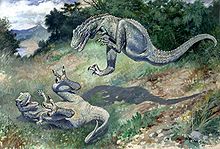 |
| Laelaps (now Dryptosaurus)
|
Knight, Charles R. (1874–1953) American artist best known for his highly influential paintings of dinosaurs and other prehistoric animals. His works have been reproduced in many books and are currently on display at several major museums in the United States. Examples of his work frequently appeared in dinosaur and paleontology books published in the US during the first half of the twentieth century. While some of his works depicted the dinosaurs as slow and sluggish, such as the iconic Brontosaurus grazing in a swamp, others, such as the Laelaps featured here prefigure the later dinosaur renaissance (although perhaps going to the opposite extreme, as Bakker's and Paul's fully endothermic dinosaurs also do). Knight was most active during the 1890s–1940s, and his work exerted a strong influence on popular culture, including both toys and movies such as the stop motion dinosaurs in Harry Hoyt's The Lost World (1925) and Ray Harryhausen's magnificent special effects (One Million Years B.C. (1966), The Valley of Gwangi (1969)).
Labyrinthodont Small to very large, primitive Paleozoic to Mesozoic amphibians defined by the complex maze-like infolding of their enamel, a feature inhereted from their lobe-finned fish ancestors. As with thecodont, this term is disliked by cladists because it does not constitute a natural clade.
Lagerstätten (more correctly called Konservat-Lagerstätten): a term coined by German paleontologists for exceptionally preserved fossil assemblages. Most contain direct evidence of soft part morphology. Examples include Mazon Creek (concretions, Carboniferous, Illinois), Solnhofen Limestone (extremely fine grained (lithographic) limestone, Jurassic, Germany), La Brea (tar pits, Pleistocene, California), Burgess Shale (carbonization, Cambrian, Canada).
Late In the geological timescale, the chronological equivalent to Upper. Often refers to a subdivision or epoch of a period, especially when the period is divided into three; e.g. "Late Jurassic".
Laurasia the Mesozoic northern supercontinent that was derived from Pangea. It comprised of North America, Eurasia (exclusive of India) and Greenland. Most of the famous Cretaceous dinosaurs are from Laurasia; Laurasia's sister continent Gondwana being inhabited by different types of animals.
Lazarus taxon a taxon that disappears from one or more periods of the fossil record, only to appear again later.
Life characteristic that distinguishes objects that have signaling and self-sustaining processes (i. e., living organisms, but could also apply to virtual life, artificial or machine life, etc) from those that do not. Living organisms undergo metabolism, maintain homeostasis, possess a capacity to grow, respond to stimuli, reproduce and, through natural selection, adapt to their environment in successive generations. There is no reason why life should only be limited to Earth; it is certain that suitable planets elsewhere in the universe would also contain evolving life. The totality of life on Earth (or any planet or self-contained ecosystem, e.g. a future base on Mars) at any moment is called the biosphere.
Limestone the most abundant of the non-clastic sedimentary rocks that is produced from the mineral calcite (calcium carbonate) and sediment. The main source of limestone is the limy ooze formed in the ocean. The calcium carbonate can be precipitated from ocean water or it can be formed from sea creatures that secrete lime such as algae and coral.
Linnaean classification hierarchical taxonomy developed by the 18th century Swedish botanist Carl von Linné, (Linnaeus). It was the first systematic classification of life on Earth, in which every species is given it's own binomial designation. So for example anatomically modern human beings are Homo sapiens, genus (the "family name") Homo and species (the specific name) sapiens. In contrast, Neanderthal man is Homo neanderthalensis. Linnaean classification provides a nested hierarchy of levels, each with its own specific characteristics. In this way any organism or species is grouped more and more specifically within the hierarchy. The Linnaean system was originally static, being based on creationism. In the 19th century, applied to the evolution of life and the modern synthesis it became evolutionary systematics, and was used to construct phylogenetic trees. Still foundational to modern biology, Linnaean classification is in the process of being superseded by cladistic systematics. Unfortunately, this latter, with its indefinite series of nested clades, lacks the categorical simplicity and ease of use of the old Linnaean system.
Lissamphibia refers to the amphibian crown group clade, that is, all living amphibians (frogs, newts, salamanders, etc) and their shared ancestors, as opposed to diverse earlier forms. Lissamphibia first appeared during the Triassic, and have been an important part of the terrestrial ecosystem from the Late Jurassic till now.
Lithologic unit or Lithostratigraphic unit a body of rock that is consistently dominated by a certain lithology or similar color, mineralogical composition, and grain size. It may be igneous, sedimentary, or metamorphic and may or may not be consolidated.
Lithosphere located above the asthenosphere, the lithosphere consists of the outer layer of earth's crust and upper mantle. The lithosphere also contains the Moho boundary. (H. Redoble, Wikiversity)
Living fossil informal term for any living species (or genus or clade) of organism which appears to be the same as a species otherwise only known from fossils and which has no close living relatives. Examples include the brachiopod Lingula and the coelacanth.
Lobe-finned fish subclass Sarcopterygii, includes lung fish, coelocanths, and their ancient ancestors and relatives. Common and diverse in the Paleozoic (especially the Devonian and Carboniferous) and Mesozoic. Instead of a normal fin, the lobe fins have a fleshy base, hence the name. These fins evolved into the limbs of amphibians, and the same bones that make up tetrapod limbs, including our own, can be recognised in these Paleozoic fossil fish.
Lower In geology, refers to lower, older strata. In the geological timescale, refers to the older rocks of a period, especially when the period is divided into three; e.g. "Lower Jurassic". Apart from specific geological contexts, this usage is now generally replaced by the more chronological descriptive term Early. In biology, an informal, "ladder of nature" like term for more primitive representatives of a particular taxon, e.g. "the lower vertebrates"; contrast with "higher".
Lyell, Charles A 19th-century scientist, principal architect of uniformitarianism and a founding father of modern geology, helping to transform the discipline into an empirical, testable science.
Macroevolution Evolution at or above the species level. The boundary between macro- and micro- is fuzzy, as some researchers prefer to include speciation in micro- and others reason that the only macro- process that gives distinctive events is speciation. Speciation events are thus, to many scientists, examples of macroevolution. Another definition is evolution too imperceptible to be observed within the lifetime of one researcher.
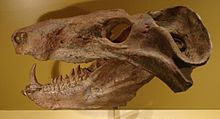 |
| Skull of Cynognathus, an Early Triassic mammal-like reptile (Therapsida: Cynodontia), combining reptile and mammal features. Karoo of South Africa.
|
Macrofossil A fossil that is large enough to be studied without a microscope.
Mammal-like reptile in evolutionary taxonomy, Subclass Synapsida, Class Reptilia. consisting of the orders Pelycosauria and Therapsida, which dominated terrestrial ecosystems from the early Permian through to the late Triassic. Form a gradation of transitional forms ancestral and leading to the mammals. One of the classic instances where the fossil record shows the detailed stages in the transformation from one major taxon to another (good for refuting creationist claims). The cladistic paradigm shift means that the term "Mammal-like reptile" can not be used because it is a paraphyletic group. But since I consider evolutionary and phylogenetic systematics to be complementary rather than contradictory, I am not buying into this argument, and so will use paraphyletic terms when appropriate.
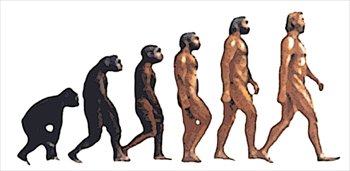 |
| The March of Progress
|
The March of Progress one of the most recognizable and misinterpreted scientific illustrations ever produced, drawn by Rudolph Zallinger, depicting a line of human evolutionary forebears lined up as if marching in a parade from left to right, and copied and parodied countless times (most often with only six hominids rather than the original fifteen). The artist never intended to portray human evolution as a single unbranched line.
Marsh, Othniel C. (1831–1899) of Yale University, was perhaps the single most influential American vertebrate paleontologist of the 19th Century. Life-long rivalry with Edward Drinker Cope over the hunt for new fossils became known as the "Bone Wars".
Mass extinction Event involving higher extinction rates than the usual degree of background extinction. See Big Five for diagram of extinction rates, and synopsis of five major extinctions
Mastodon large prehistoric browsing proboscidean known from the Pleistocene of North America; the term mastodon is also applied to other species, some of which (such as Gomphotheres) were unrelated.
Megafauna animal life, generally specifically applied to terrestrial vertebrate, of exceptionally large size. Dinosaurs and large mammals such as proboscideans (mastodons, elephants, etc), rhinos, and so on are classic examples. Because they are so striking and charismatic, megafauna often feature in nature documentaries, books and artwork on the history of life, and so on.
Meme controversial concept proposed by Richard Dawkins. A meme is a "a unit of cultural inheritance, hypothesized as analogous to the particulate gene and as naturally selected by virtue of its 'phenotypic' consequences on its own survival and replication in the cultural environment." A meme can be an idea, skill, story, or custom, which is passed from one person to another by imitation or teaching. Some theorists argue that memes are the cultural equivalent of genes, and reproduce, mutate, are selected, and evolve in a similar way. The study of memes is called memetics.
Mendel, Gregor Johann (1822–1884) Austrian monk whose study of the inheritance of certain traits in pea plants, led to insights into the mechanisms of heredity that are the foundation of genetics today.
Mesozoic the second of the three Phanerozoic eras of the geological timescale, between the Paleozoic and the Cenozoic, and lasting from 251 to 65.5 million ago. More or less equivalent (especially in the popular imagination) to the "age of reptiles". Dinosaurs, pterosaurs, marine reptiles, ammonites, gymnosperms, and primitive mammals and birds all flourished. The word Mesozoic is derived from the reek terms μέσος (mesos, "middle"), ζωή (zōē, "animal life") and -ικός (-ikos, an adjective-forming suffix). Includes three periods: the Triassic, Jurassic, and Cretaceous.
Microfossil A fossil so small that it must be studied with a microscope.
Micron Micrometer, a unit of measure, used for example when describing protists and microfossils. There are one million micrometers in one meter.
Mimicry imitative behavior, one species resembling one another, and gaining advantages as a result. For example harmless flies that have the same colouration as bees and wasps. Because predators know that wasps sting they tend to avoid anything that looks like them. See Batesian mimicry and Müllerian mimicry.
Miocene A epoch of the late Tertiary period, spanning the time between 23.8 and 5.3 million years ago. It is named after the Greek words μείων (meion, "less") and καινός (kainos, "new").
Moderate Icehouse climate, punctuated by ice ages; Orogeny in northern hemisphere. Modern mammal and bird families become recognizable. Horses and mastodons diverse. Grasses become ubiquitous. First apes appear (for reference see the article: "Sahelanthropus tchadensis"). Kaikoura Orogeny forms Southern Alps in New Zealand, continues today. Orogeny of the Alps in Europe slows, but continues to this day. Carpathian orogeny forms Carpathian Mountains in Central and Eastern Europe. Hellenic orogeny in Greece and Aegean Sea slows, but continues to this day. Middle Miocene Disruption occurs. Widespread forests slowly draw in massive amounts of CO2, gradually lowering the level of atmospheric CO2 from 650 ppmv down to around 100 ppmv.
Mississippian A subperiod of the Paleozoic era, spanning the time between 360 and 325 million years ago. It is named after the Mississippi River valley, which contains good exposures of rocks of this age. The term is used by American geologists as a period ranking of geological time, but not European ones, who refer instead to the "Lower Carboniferous". The Mississippian has since been standardised as subperiod of the Carboniferous.
Large primitive trees, first land vertebrates, and amphibious sea-scorpions live amid coal-forming coastal swamps. Lobe-finned rhizodonts are dominant big fresh-water predators. In the oceans, early sharks are common and quite diverse; echinoderms (especially crinoids and blastoids) abundant. Corals, bryozoa, goniatites and brachiopod (Productida, Spiriferida, etc.) very common, but trilobites and nautiloids decline. Glaciation in East Gondwana. Tuhua Orogeny in New Zealand tapers off. Variscan orogeny occurs towards middle and late Mississippian Periods.
Mitochondria (singular: mitochondrion) A small round organelle found in most cells in nearly all eukaryotes; produce enzymes that convert food to energy. Because mitochondria are generally carried in egg cells but not in sperm, mitochondrial DNA is inherited from mothers but not fathers. Hence it is possible to trace ancestry through the mother's line (see also mitochondrial Eve).
Mitosis Cell division. All cell division in multicellular organisms occurs by mitosis except for the special division called meiosis that generates the gametes.
Molecular clock the premise that the rate at which mutational changes accumulate is constant over time.
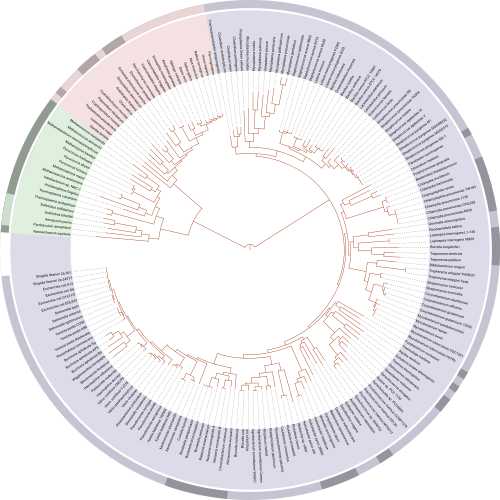 |
| Tree of life according to molecular phylogeny
By Ivica Letunic. Retraced by Mariana Ruiz Villarreal |
Molecular phylogeny, molecular systematics Use of molecular data as characters for phylogenetic analyses. Generally speaking, the more closely related two organisms are, the more similar their gene sequences will be. By statistically comparing the similarities and differences in the sequence between the same gene from various organisms, we can deduce the pattern of how those organisms are related, and shown in a phylogram.
Mollusca also mollusk (American spelling) major phylum of invertebrate animals distinguished by a shell-secreting mantle and radula teeth. Includes chitons, bivalves, gastropods, cephalopods, and various minor groups. An important component in marine ecosystems, also many freshwater and terrestrial forms. Cambrian to recent.
Monophyletic group, monophyly in cladistics refers to those phylogenetic groups in which no descendent is a part of any other group; also called a clade.
Monospecific a higher taxon (family, genus, etc) that contains only a single species.
Moore, Raymond C. (1892–1974) American paleontologist, co-author (with Lalicker and Fischer) of Invertebrate Fossils (1952) and founder and first editor of the multi-volume Treatise on invertebrate paleontology (1953–ongoing). He was also a talented artist who illustrated the book Invertebrate Fossils.
Morphogenesis biological process that causes an organism to develop tissues, organs and shape.
Morphology The study of the form and structure of organisms, such as animals and plants and their fossil remains.
Morphospace a representation of the possible shape, structure, or form of an organism, usually with two or three variables plotted on a grid or diagram.
Mosasaur giant marine reptiles, probably related to the ancestors of snakes. They dominated the seas during the late Cretaceous.
Mutation An error in duplication of genetic material which results in a different sequence of and/or a different number of base pairs in the copy than were in the original. Mutation creates new alleles.
Natural selection The differential reproduction and, thereby, transmission of alleles between generations, of individuals in a population, due to heritable variation in a trait or traits which they possess. This is one mechanism by which evolution can occur.
Darwin's theory of evolution through natural selection can be summarised by means of three principles:
-
Principle of variation. Among individuals within any population, there is variation in morphology, physiology, and behavior.
Principle of heredity. Offspring resemble their parents more than they resemble unrelated individuals.
-
Principle of selection. Some forms are more successful at surviving and reproducing than other forms in a given environment.
Griffiths AJF, Miller JH, Suzuki DT, et al. "Introduction", in An Introduction to Genetic Analysis. 7th edition. New York: W. H. Freeman; 2000
Conceived independently and then jointly published by Darwin and Wallace, and substantially elaborated upon in the early part of the twentieth century with the rediscovery of Mendelian genetics and then advances in population genetics.
Naturalism any of several philosophical stances, typically those descended from materialism and pragmatism, that interpret the world and consciousness in such a way that does not require a supernatural explanation.
Nautiloid the pearly nautilus and its ancestors. Include a large assemblage of mostly Paleozoic cephalopods with straight, curved, loosely or tightly coiled shells and simple sutures. Common and most diverse from the Ordovician to the Devonian, after which time they were increasingly supplanted by ammonoids. Nevertheless, nautiloids much like the modern Nautilus continued virtually unscathed even when the various groups (goniatite, ceratite, ammonite) of their advanced ammonoid cousins died out, perhaps because they inhabited deeper water and were not so dependent on the plankton-based food chain. The largest Paleozoic nautiloids had straight shells several meters or more in length, but most species were of more modest proportions.
Nekton Used to describe aquatic organisms that swim, as opposed to plankton which drift.
Nondirectionality (in evolution) as here defined, the premise that evolution does not have a direction, that nature does not tend towards greater complexity, that it is misleading to speak of "lower", "simpler", or "primitive" or "higher" or "advanced". Contrast with directionality.
Non-missing link Although creationists often claim that no transitional forms are known in the fossil record, in fact the reverse is the case. As it would be oxymoronic to refer to these intermediate species by their popular moniker as "missing link", Note that even though, in view of the vagaries of the fossil record, the non-missing link may not necessarily be the actual, literal, common ancestor of all later species in that lineage (although in some cases where stratigraphic preservation is very good it might),it would certainly be a closely related type. I have coined the informal term "non-missing link". See also transitional forms.
Noosphere (sometimes spelt noösphere): thesis developed, either independently or jointly, by Édouard Le Roy (French mathematician and Bergsonian philosopher), Pierre Teilhard de Chardin, and Vladimir Vernadsky in the 1920s, to describe the "sphere of human thought" (Greek νόος, noos, mind), by analogy with "geosphere", "atmosphere", "biosphere", etc. The Noosphere is considered the latest sphere of earth evolution, but is interpreted differently by Teilhard, Vernadsky, and modern authors. For example today it is frequently identified with the Internet.
Notochord A rodlike cord of cells in lower chordates that forms the main lengthwise support structure of the body.
Oligocene An epoch of the early Tertiary period, spanning the time between 33.7 and 23.8 million years ago. It is named after the Greek words ὀλίγος (oligos, "little", "few") and καινός (kainos, "new").
Warm but cooling climate, moving towards Icehouse; Rapid evolution and diversification of fauna, especially mammals. Major evolution and dispersal of modern types of flowering plants.
Ordovician The second earliest period of the Paleozoic era, spanning the time between 505 and 440 million years ago. It is named after a Celtic tribe called the Ordovices.
Invertebrates diversify into many new types (e.g., long straight-shelled cephalopods). Early corals, articulate brachiopod (Orthida, Strophomenida, etc.), bivalves, nautiloids, trilobites, ostracods, bryozoa, many types of echinoderms (crinoids, cystoids, starfish, etc.), branched graptolites, and other taxa all common. Conodonts (early planktonic vertebrates) appear. First green plants and fungi on land. Ice age at end of period.
Organelle a specialized subunit within a cell that has a specific function, and is usually separately enclosed within a double membrane (or lipid bilayer).
Ornithischian derived from the Greek terms ὄρνιθος (ornithos, "bird"), ἰσχίον (iskhion, "haunches") and -ία (-ia, nominal form of an adjective-forming suffix); names any member of one of the three main clades of dinosaurs, this diverse group included plated (stegosaur), armoured (ankylosaur), generalised herbivores (iguanodonts and "duck billed" hadrosaurs) and head-butting and horned (ceratopsian) dinosaurs. Rare during the Triassic, they were most abundant during the Cretaceous.
Orogeny The tectonic process in which large areas are folded, thrust-faulted, metamorphosed, and subjected to plutonism. The cycle ends with uplift and the formation of mountains.
Osteology derived from the Greek terms ὀστέον (osteon, "bone") and λόγος (logos, "explanation"); the study of the various parts of the vertebrate skull and skeleton. Regardless of how much neontology and soft-part morphology, paleobiological reconstruction (especially popularised by the dinosaur renaissance of Ostrom, Bakker, and Paul), developmental biology, and molecular phylogeny increase in importance in studying the evolution of vertebrates, along with trace fossils and footprints, the study of the most durable and commonly preserved parts of the organism, the teeth (in small delicate animals such as Mesozoic mammals) and bones will always remain an essential element in any analysis of vertebrate phylogeny and paleontology. Classic vertebrate paleontology textbooks and papers such as the works of Zittel, Romer and Carroll are full of dense descriptions on the skeletal and cranial minutiae of various extant and extinct taxa, and even more so this is the case with technical journals. Thus material, essential for listing traits for cladistic analysis, makes up a large part of the "Vertebrates" section of Palaeos (originally, "Vertebrate Notes").
Ostracod names any member of Class Ostracoda, small crustaceans with dorsally located bivalved carapace which is commonly heavily calcified, common as microfossils and very useful for biostratigraphy.
 |
| The ostracoderm Hemicyclaspis
|
Ostracoderm name given to a diverse assemblage of highly distinctive armoured jawless fish from the Ordovician, Silurian and Devonian periods. The term is now rarely used in scientific literature, as they are now known to consist of a number of different lineages, representing a paraphyletic or polyphyletic grouping. Nevertheless it is a useful label for referring to these bizarre creatures from the early days of vertebrate evolution.
Oxygen crisis being a crisis for the earlier mentioned Archaea (one of the three domains of life), in that photosynthetic blue-green algae totally transformed the Earth by changing the atmosphere from reducing to oxygenating, thus paving the way for eukaryote life.
Paleo geek, paleo nerd what you and I are; someone with a disproportionate interest in, and knowledge concerning, the history of life on Earth.
Paleoart informal term first coined by Mark Hallett for art that depicts subjects related to paleontology. These may be representations of fossil remains or depictions of the living creatures and their ecosystems.
Paleo artists therefore are any of those wonderfully talented people who produce those beautiful reconstructions of prehistoric organisms that help to brighten up the web (and Palaeos too!).
Paleobiology The study and understanding of fossil organisms from a biological perspective. Whereas paleontology looks at the fossil bone, shell, or leaf for its own sake, paleobiology seeks to understand the organism that produced those remains.
Paleoceanography The study of oceans in the geologic past, including its physical, chemical, biologic, and geologic aspects.
Paleocene Earliest epoch of the Tertiary period, spanning the time between 65 and 55.5 million years ago. It is named after the Greek words παλαιός (palaios, "old") and καινός‚ (kainos, "new").
Climate tropical. Modern plants appear; mammals diversify into a number of primitive lineages following the extinction of the dinosaurs. First large mammals (up to bear or small hippo size). Alpine orogeny in Europe and Asia begins. Indian Subcontinent collides with Asia 55 Ma, Himalayan Orogeny starts between 52 and 48 Ma.
Paleoclimate The climate of a given period of time in the geologic past.
Paleoecology the study of the relationships between species in fossil assemblages.
Paleomagnetism Refers to the study of the magnetic properties of rocks and minerals. This demonstrates to us that both the strength and direction of Earths magnetic field is not constant. Each rock and mineral tells its own story at a particular moment in time.
Paleontology The scientific study of ancient life (palaeos = ancient, ontos = being, logos = speech, reason, hence study of), through examination of fossil remains and the fossil record. Includes subdivisions such as Vertebrate, Invertebrate, and Micro- paleontology. Contrast with neontology. Paleontologists have access to many extinct forms of life, including many transitional and ancestral forms, and information regarding their stratigraphic or temporal position in the geological timescale, paleobiology, paleoecology, paleoclimatology, etc extend this to environmental, geographic, and other areas to provide a comprehensive history of the Earth. Because of the fragmentary or partial nature of many fossils, reconstructing extinct life and extinct environments is often more like forensic science than biology or ecology.
Paleozoic the first and longest of the three Phanerozoic eras of the geological timescale, lasting from 542 to 251 million years ago. Characterised by the emergence and dominance of multicellular life in the Cambrian explosion, and the succession of invertebrates, fish, and early land plants, amphibians and reptiles. Includes six periods: the Cambrian, Ordovician, Silurian, Devonian, Carboniferous, and Permian. The word Paleozoic is derived from the Greek terms παλαιός‚ (palaios, old), ζωή (zōē, "animal life") and -ικός‚ (-ikos, an adjective-forming suffix).
Palynology The study of pollen, living and fossil.
Pangea, Pangaea derived from the Greek terms πᾶν (pan, "all") and γαῖα (gaia, "earth"); is a supercontinent that existed during the Permian and Triassic, and included most of the Earth's continental crust. During this time, terrestrial faunas were often quite uniform, as there were few geographic barriers, although there were distinct vegetation zones (biomes). Beginning in the Jurassic, Pangea divided into Laurasia in the north and Gondwana in the south.
Panspermia the theory that life on Earth was seeded from other planets, whether accidentally (through microbes floating on comets or carried in meteorites) or deliberately (through intelligent extraterrestrials - see intelligent design). The version of panspermia that only considers human beings is called the Ancient Astronaut hypothesis.
Paradigm the set of practices and methodologies that define a scientific discipline at any particular period of time.
Parallel evolution the development of a similar trait or traits in related, but distinct, species descending from the same ancestor, but from different clades or lineages.
Paraphyly, paraphyletic group a technical term in Cladism, used to refer to groups that have a common ancestry but which do not include all descendents. e.g. reptile is a paraphyletic group because reptiles evolved into mammals and birds. Evolutionary systematics regards paraphyletic groups as valid, whereas cladistics does not. Contrast with monophyly.
Parsimony Also known as Occam's Razor, the principle that recommends choosing the simplest of two competing hypotheses. A central premise in cladistics, where computer algorithms routinely generate huge numbers of cladistic trees. When reconstructing the phylogenetic relationships, parsimony implies that we should prefer the branching pattern that requires the fewest number evolutionary changes. Unfortunately, the picture becomes more complex when homoplasy is taken into account.
Paul, Gregory S. paleo artist and author of several popular books, whose work played a major role in defining the way we think of dinosaurs.
Pelagic Referring to open water marine habitats free of direct influence of the shore or ocean bottom. Pelagic organisms are generally free-swimming (nektonic) or floating (planktonic).
 |
| The herbivorous Permo-Carboniferous pelycosaur Edaphosaurus
|
Pelycosaur Synapsid reptiles common during the early Permian, include distinctive fin-back carnivorous Dimetrodon and herbivorous Edaphosaurus (the fin serving for thermoregulation), as well as more conventionally looking animals.
Pennsylvanian A subperiod of the Carboniferous period of the Paleozoic era, spanning the time between 325 and 286 million years ago. It is named after the state of Pennsylvania where rocks of this age are widespread.
Winged insects radiate suddenly; some (esp. Protodonata and Palaeodictyoptera) are quite large. Amphibians common and diverse. First reptiles and coal forests (scale trees, ferns, club trees, giant horsetails, Cordaites, etc.). Highest-ever atmospheric oxygen levels. Goniatites, brachiopod, bryozoa, bivalves, and corals plentiful in the seas and oceans. Testate forams proliferate. Uralian orogeny in Europe and Asia.
Period a unit or division of geological time, usually lasting several tens of millions of years, and hence intermediate in duration between era and epoch. By convention, each period is divided into two or more epochs. In terms of geological strata, rather than time, the word "system" is traditionally used, although this now seems to be falling out of favour, and only found in older books.
 |
| Permian period, featuring the carnivorous pelycosaur Dimetrodon and the large amphibian Eryops
|
Permian The final period of the Paleozoic era. Landmasses unite into supercontinent Pangaea, creating the Appalachians. End of Permo-Carboniferous glaciation. Synapsid reptiles (pelycosaurs and therapsids) become plentiful, while parareptiles and temnospondyl amphibians remain common. In the mid-Permian, coal-age flora are replaced by cone-bearing gymnosperms (the first true seed plants) and by the first true mosses. Beetles and flies evolve. Marine life flourishes in warm shallow reefs; productid and spiriferid brachiopod, bivalves, forams, and ammonoids all abundant. Permian–Triassic extinction event occurs 251 Ma: 95% of life on Earth becomes extinct, including all trilobites, graptoloids, and blastoids. Ouachita and Innuitian orogenies in North America. Uralian orogeny in Europe/Asia tapers off. Altaid orogeny in Asia. Hunter-Bowen Orogeny on Australian Continent begins (c. 260–225 Ma), forming the MacDonnell Ranges.
Permo-Carboniferous informal period of time encompassing the Carboniferous and Permian periods, or alternatively the latter parts of the Carboniferous and early part of the Permian period. Important in considering late Paleozoic geology, global climate change (glaciation), and plant, invertebrate, and tetrapod ecology and evolution.
Phanerozoic the most recent, and current, of the four eons of the geological timescale, the time of diverse and complex life, complex ecosystems, and an oxygen-rich atmosphere. Divided into Paleozoic, Mesozoic, and Cenozoic. The Phanerozoic begins with the start of the Cambrian period, and continues to today.
Pheromone A chemical substance produced by some organisms and emitted into the environment to communicate with others of the same species; play an important role in the social behavior of certain species.
Phylogenetic systematics cladistics as developed by Hennig, which uses recognisable synapomorphies to determine natural groups (clades), and emphasises phylogeny (as opposed to pattern cladistics which claimed that phylogeny is impractical). More recently has been subsumed under phylogenetics.
Phylogenetic tree See Tree.
Placoderms A peculiar group of primitive armored jawed fish, superficially similar to Ostracoderms, and found almost exclusively in rocks from the Devonian Period.
Plankton Aquatic organisms that drift, or swim weakly. Hence Planktonic describing aquatic organisms that float.
Plant traditionally and taxonomically meaninglessly used to include all photosynthetic organisms and fungi. In the Whittaker–Margulis scheme one of the three kingdoms of multicellular life, include the land plants and (in later classifications) green algae.
Plate tectonics The theory, proposed by Alfred Wegener, that the surface of Earth is made of a number of plates, which have moved throughout geological time to create the present-day positions of the continents. Plate tectonics explains the location of mountain building, as well as earthquakes and volcanoes. The rigid plates consist of continental and oceanic crust together with the upper mantle, which "float" on the semi-molten layer of the mantle beneath them, and move relative to each other across the planet. Six major plates (Eurasian, American, African, Pacific, Indian, and Antarctic) are recognized, together with a number of smaller ones. The plate margins coincide with zones of seismic and volcanic activity.
Plesiosaur group of mesozoic marine fish-eating reptiles (Plesiosauria/Plesiosauroidea) characterised by a long flexible neck, small head, and broad, turtle-like body. The closely related pliosaurs had a large head and short neck
Pleistocene An epoch of the Quaternary period, spanning the time between 1.8 million years ago and the beginning of the Holocene at 8,000 years ago. The period of the last ice age, characterised by many large mammals (Pleistocene megafauna), as well as modern plants and invertebrates. Evolution of anatomically modern humans. Dawn of human stone-age cultures, with increasing technical complexity relative to previous ice age cultures, such as engravings and clay statues (e.g. Venus of Lespugue), particularly in the Mediterranean and Europe. Lake Toba supervolcano erupts 75000 years before present, causing a volcanic winter that pushes humanity to the brink of extinction. Ends with Oldest Dryas, Older Dryas/Allerød and Younger Dryas climate events, with Younger Dryas forming the boundary with the Holocene.
Pliocene Final epoch of the Tertiary period, spanning the time between 5.3 and 1.8 million years ago. It is named after the Greek words πλεῖον (pleion, "more") and καινός (kainos, "new"). The Miocene and Pliocene represented the time of greatest abundance and diversity of the mammals. Characterised by a cooling climate and ice sheets in Antarctica.
Intensification of present Icehouse conditions, present (Quaternary) ice age begins roughly 2.58 Ma; cool and dry climate. Australopithecines, many of the existing genera of mammals, and recent mollusks appear. Homo habilis appears.
Pliosaur group of mesozoic marine apex predators related to plesiosaurs but with a large head and streamlined body. The mesozoic equivalent of toothed whales
Polyphyly, polyphyletic group A group that does not share a common ancestor, but is defined on the basis of independently acquired or convergent (non-homologous) character states. Examples for polyphyletic groups would be the old taxon Pachydermata which includes the thick-skinned hippos, rhinos and elephants,
Polytomy in cladistics, a node where more than two lineages descend from a single ancestral lineage. This indicates either that we don't know how the descendent lineages are related or the descendent lineages speciated simultaneously.
Population A group of potentially inter-breeding individuals of the same species found in the same place at the same time.
A group of organisms, typically a single species, and typically isolated from other members of its species in some manner.
Population ecology major subfield of ecology that deals with the dynamics of species populations and how these populations interact with the environment.
Precambrian older term, now rarely used, to refer to the expanse of geological time prior to the Cambrian period. Because the Cambrian was when animal fossils first appear, it, and the following periods to the present, were called the Phanerozoic, and was contrasted with earlier ages and their corresponding rock strata, often highly metamorphised, and devoid of fossils (or characterised only by stromatolites). The Precambrian was also known as the Cryptozoic (hidden life), and originally referred to as "Primary" strata. Current understanding and research has revealed the Precambrian to be a time of diverse geological, climatological, and microbiological activity and evolution. Current usage replaces "Precambrian eon" with three distinct eons, Hadean, Archean, and Proterozoic, with complex life forms only appearing at the end of the latter, during the Edicaran period.
Primary producer an autotroph that obtains energy directly from the nonliving environment through photosynthesis (e.g. a plant) or less commonly through chemosynthesis (some types of bacteria).
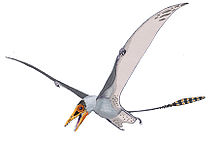 |
| Reconstruction of Sordes pilosus, a Jurassic pterosaur. Fossils show that these animals had a furry coating, which implies they were warm-blooded like birds and mammals.
|
Protist, protoctist kingdom (in the Linnaean classification of mostly unicellular organisms, which do not fit into either the categories of animal or plant. For now, protist is retained as a generic term for (mostly) unicellular eukaryotes, but it is not considered a taxon or kingdom, more a sort of wastebasket taxon, for which "unicellular eukaryote" can usually be substituted.
Protozoa originally "protist" or wastebasket taxon for animal-like (motile, heterotrophic) unicellular eukaryotes; Cavalier-Smith's system one of the six kingdoms of life, including the first eukaryotes, flagellate, and amoeboid forms.
Pterosaur derived from the Greek terms πτερόω (pteroō, "winged") and σαῦρος (sauros, "lizard"); names any member of a group of Mesozoic flying reptiles characterised by a greatly elongated fourth finger that supported a membranous wing (in contrast to bats in which all five digits are elongated; artwork and movies that give pterosaurs bat-like wings are inaccurate) thus the moniker "pterodactyl", derived from the Greek terms πτερόω (pteroō, "winged") and δάκτυλος (daktulos, "finger"). They include the largest animals ever to fly, although others were of more modest proportions. Not dinosaurs, but closely related.
Punctuated Equilibria more commonly known an Punctuated evolution, an evolutionary theory by Eldredge & Gould 1972 that argues that new species evolve suddenly and in geographically isolated areas, where it is rarely observed. For the rest of the time, species change slowly, if at all
Quaternary The second period of the Cenozoic era (following the Tertiary), spanning the time between 1.8 million years ago and the present (in terms of duration, this is the shortest period, equivalent to a standard age). It contains two epochs: the Pleistocene and the Holocene. It is named after the Latin words quăternĭo ("number four") and -ārius (nominal form of an adjective-forming suffix), and refers to the earliest (19th century) stratigraphic systems (Primary, Secondary, Tertiary, and Quaternary). Although there was a movement to scrap both Tertiary and Quaternary in favour of more modern terms such as Paleogene and Neogene, this was not successful, and in current geological timescales the Quaternary has been restored or retained. The Quaternary includes both the Ice Age with its distinctive megafauna, and the modern, human-dominated period of Earth history.
r-selection, r-selected species A species that produces a large number of off-spring, each of which receives little care (quantity rather than quality). R-selected species are better suited for variable or unpredictable environments.
Radial symmetry An organism (or any object) that can be divided into two matching halves by many different lines, which all intersect one another at a single point in the center.These organisms resemble a pie where several cutting planes produce roughly identical pieces. An organism with radial symmetry exhibits no left or right sides, or specific front or rear. They have a top and a bottom (dorsal and ventral surface) only. Examples include plants, sponges, Cnidaria (corals, jellyfish, etc), and echinoderms. Contrast bilateral symmetry.
Random Unpredictable in some way. Mutations are "random" in the sense that the sort of mutation that occurs cannot generally be predicted based upon the needs of the organism. However, this does not imply that all mutations are equally likely to occur or that mutations happen without any physical cause. Indeed, some regions of the genome are more likely to sustain mutations than others, and various physical causes (e.g., radiation) are known to cause particular types of mutations.
Rank the hierarchical level of a supra-specific taxon, according to the Linnaean approach to classification. The eight ranks are kingdom, phylum (added by Haeckel), class, order, family, tribe (used mostly in botany, much more rarely in zoology and paleontology), genus, and species, plus optional intermediate grades represented by the suffixes super-, sub- and infra-. Ranks are rejected by most cladists.
Relative age, relative time A statement of the approximate age of an object or feature in comparison with some other object or feature, rather than in terms of its age in years.
Dating of rocks and geologic events by their positions in chronological order without reference to number of years before the present. Compare with Absolute age.
Reproductive isolation Isolation of one species or population from another species or population by differences in reproductive traits or habits. The two species or populations may or may not share the same environmental range. An example of two species being reproductively isolated are similar species of animals that breed at different times of the year.
 |
| Class Reptilia - a paraphyletic taxon
diagram by Stanislav Traykov & Fatapatate via Wikimedia
|
Ribonucleic acid (RNA) A molecule similar to DNA, but with only a single strand, by which the genetic code of DNA is converted into proteins in cells. It has three forms: Messenger RNA, ribosomal RNA, and transfer RNA. Some viruses carry RNA as their genetic material instead of DNA. There has been speculation that an "RNA world" preceded current life on Earth.
Rudist A type of extinct bivalve mollusk from the Jurassic and especially the Cretaceous that had two different sized and shaped shells; they usually were attached to the substrate and were either solitary or in reef-like masses.
Rugose derived from the Latin term rūgōsus ("wrinkled"); names any member of Order Rugosa, Paleozoic group of mostly solitary, but some colonial, stony corals; 800 genera known. Common as fossils.
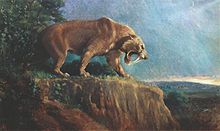 |
| Smilodon fatalis
Illustration by Charles R Knight. |
Sabre-tooth cat commonly but misleadingly called "sabre-tooth tiger" (tigers are members of the true cat group), a type of extinct big cat of the subfamily Machairodontinae, characterised by the greatly elongated canine teeth. This feature evolved independently at least three times among cat-like mammals, as well as twice among marsupials and twice (gorgonopsids and therocephalia) among mammal-like reptiles. The best known species is Smilodon fatalis, a stocky, lion-sized beast known from hundreds of skeletons of animals that became trapped in the La Brea Tar Pits.
Sauropod, sauropodomorph derived from the Greek terms σαῦρος (sauros, "lizard"), πόδα (poda, "foot") and μορφή (morphē, "form"); a misleading name for these giant creatures with their compact short-toed feet. One of the three main clades of dinosaurs, the other two being theropods and ornithischians. Early sauropodomorphs, called prosauropods, were small to medium sized animals, but they quickly grew to become sauropods proper, the largest animals to walk the Earth. Sauropods are characterised by very small heads (relative to the overall body), long to very long necks and tails, solid pillar-like legs, and massive dorsal vertebrae. At one time they were believed to be sluggish semi-aquatic wallowers in swamps, unable to walk on land. It is now known that they were active and fully terrestrial animals, much like elephants. Adults were so large they were immune to predation even from the biggest theropods.
Scala Naturae meaning "natural ladder" in Latin, is a sort of proto-taxonomy first developed by Aristotle, according to which the natural world can be arranged in a single linear series from inanimate matter through plants, invertebrates, higher vertebrates, and finally man. Overlaps and sometimes synonymous with the great chain of being. Remained a central idea in natural philosophy until the early or mid 19th century.
Science a methodical and naturalist approach to the acquisition of knowledge, by means of empirical method, hypothesis, experiment, and conformation or refutation. Science does not offer absolute answers, but rather increasingly refined insights regarding the nature of the material world, on the basis of available evidence.
Sediment Solid unconsolidated rock and mineral fragments that come from the weathering of rocks and are transported by water, air, or ice and form layers on the Earth's surface. Sediments can also result from chemical precipitation or secretion by organisms.
Sedimentary Rock A rock that is the result of consolidation of sediments.
Selective pressure any environmental factors such as scarcity of food or extreme temperatures that favour the survival of only those organisms with characteristics that provide resistance or adaptability.
Self-organization process in which the internal organization of a system, normally an open system, increases in complexity without being guided or managed by an outside source. Self-organizing systems typically (though not always) display emergent properties. See also Directional Evolution.
Sequencing any of several methods and technologies that are used for determining the order of proteins in a cell, or nucleotide bases (adenine, guanine, cytosine, and thymine) in a molecule of RNA or DNA. An essential element in molecular phylogeny.
Shale a fine-grained sedimentary rock formed by the compaction of silt, clay, or sand that accumulates in deltas and on lake and ocean bottoms.
Silurian A period of the Paleozoic, spanning the time between 440 and 410 million years ago. It is named after a Celtic tribe called the Silures.
First Vascular plants (the rhyniophytes and their relatives), first millipedes and arthropleurids on land. First jawed fishes, as well as many armoured jawless fish, populate the seas. Sea-scorpions reach large size. Tabulate and rugose corals, brachiopod (Pentamerida, Rhynchonellida, etc.), and crinoids all abundant. Trilobites and mollusks diverse; graptolites not as varied. Beginning of Caledonian Orogeny for hills in England, Ireland, Wales, Scotland, and the Scandinavian Mountains. Also continued into Devonian period as the Acadian Orogeny, above. Taconic Orogeny tapers off. Lachlan Orogeny on Australian Continent tapers off.
Singularity In mathematics, a point at which a given mathematical object is not defined or not well-behaved, for example infinite or not differentiable. In the natural sciences, a point in spacetime where the laws of physics break down, for example where gravitational forces cause matter to have an infinite density and zero volume (as in a Black Hole). In transhumanism and futurism, the end of history as we know it, the point (Technological singularity) at which accelerating change and technological progress becomes so rapid, or alternatively that an exponential growth of artificial intelligence surpasses human levels of intelligence, so that it becomes impossible to predict the nature of any post-singularity intelligence or technological civilization. See also posthuman.
Similarity the degree to which two or more species or other taxa resemble each other. Similarity could be the result of common descent and divergence (homology) or convergence (homoplasy).
Sixth extinction the on-going anthropogenic mass-extinction, so called because it is comparable in impact to the preceding big five. The term was coined or popularised by Richard Leakey and Roger Lewin in their 1996 book The Sixth Extinction: Patterns of Life and the Future of Humankind. In his book The Future of Life (2002), E.O. Wilson calculated that, if the current rate of human disruption of the biosphere continues, one-half of Earth's higher lifeforms will be extinct by 2100.
Snowball Earth hypothesis that the Earth's surface became entirely or nearly entirely frozen one or more times during the Precambrian. The most recent snowball was about or earlier than 650 million years ago (Neoproterozoic era, during the appropriately named Cryogenian period). Evidence includes glacial deposits found at what at the time were tropical paleolatitudes, It is not known whether the Earth was a full snowball, or a "slushball" with a thin equatorial band of open (or seasonally open) water.
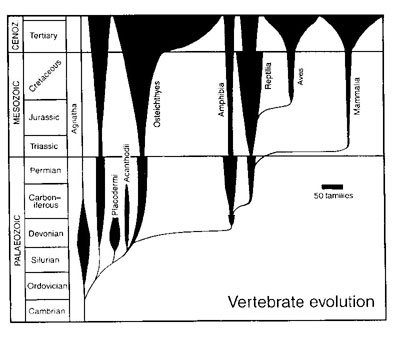 |
| Spindle Diagram, showing evolution of the vertebrates, showing the relative importance of the major groups through time. The vertical axis represents geological time, and the horizontal axis represents the diversity of each group, in terms of number of families. Includes both monophyletic clades, such as Chondrichthyes, Placodermi, Acanthodii, Aves, and Mammalia, and paraphyletic groups such as Agnatha, Amphibia, and Reptilia.
|
Sociobiology scientific study that explains and examine social behavior within an evolutionary that context. Often considered a branch of biology and sociology, it also draws from ethology, anthropology, evolution, zoology, archaeology, population genetics, and other disciplines. Popularised in 1975 with the publication of Edward O. Wilson's book, Sociobiology: The New Synthesis.
Species Highly controversial term given a variety of definitions by biologists. Currently, the Biological Species Concept (BSC) is widely popular: Groups of actually or potentially interbreeding populations, which are reproductively isolated from other such groups (Mayr, 1963, Animal Species and Evolution). See other species definitions.
Speciation The the basic process of evolution by which new species appear. Allopatric speciation is supposed to be caused by the physical separation of specimens of what was one and the same species. The classical example is Darwin's work on the finches of the Galapagos Islands. Peripatric speciation is taken to occur in the same geographic area—without severance of the gene flow—due to ecological differences, e.g. the existence of two different ecological niches into which an existing species can specialize.
Stegosaur herbivourous armoured mostly Jurassic "bird hipped" dinosaurs equipped with two rows of upright bony plates along the back and spines on the tail and, in some species, also the hips
Stratigraphy Branch of geology concerned with the formation, composition, ordering in time, and arrangement in space of sedimentary rocks.
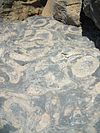 |
| Stromatolites, Zebra River Canyon, Namibia - Proterozoic age
|
Stromatolite algae mats, formed in shallow water by microorganisms, especially cyanobacteria accreting grains in layers. Rare now, but common during the Proterozoic. The oldest stromatolites are known from the Archean, they are among the oldest records of life on Earth. Image (right) Wikipedia.
Subspecies A grouping of organisms less inclusive than a species, and often capable of interbreeding with other subspecies of the same species.
Subtropical Bordering on the tropics or nearly tropical.
Superorganism an organism consisting of many (sometimes thousand, in some cases even millions) individuals working together as a single functional somatic or social unit, e.g. a jellyfish (where individual organisms fulfill the role of different organs) or an ant colony (where the superorganism is more dispersed in space, but also more intelligent).
Superposition A statement of relative age in layered rocks: In a series of sedimentary rocks that has not been overturned, the topmost layer is always the youngest and the bottommost layer is always the oldest.
Supertree the synthesis of a number of distinct cladograms, combining morphological, molecular, and other data from the different individual phylogenies in a single, more comprehensive dendrogram.
Suspension feeder aquatic or marine organisms which capture food suspended in the water column. Suspension feeders that use a filter to capture food (e.g. brachiopods, crinoids, etc.) are called filter feeders. Suspension feeders were more predominant in Paleozoic ecosystems, where they often would form tiers.
Suture the line of partition between gas-filled chambers in shelled cephalopods. Sutures can only be seen when the outside of the shell has been removed, and suture pattern is used to characterize many ammonoid groups. Nautiloids have simple sutures, ammonites more complex ones.
Synapomorphy An character trait or "apomorphy" shared by (syn-) several taxa, where the trait in question originates in their last common ancestor. Being shared by multiple taxa, synapomorphies can be used to diagnose (describe) a clade (a monophyletic group). Compare with homology.
Systematics, Systematic Biology the study of the diversification of life on the planet Earth, both past and present, and the relationships among living things through time. Includes taxonomy and phylogeny.
Systems theory the study of systems in general, with the goal of elucidating principles that can be applied to all types of systems in all fields of research. The term originates from Ludwig von Bertalanffy's General System Theory (GST). See also complex system, emergence.
Tabulate Order Tabulata. Paleozoic group of exclusively colonial organisms traditionally classified as stony corals, although other interpretations have been suggested (e.g. sponges). Common as fossils, 280 genera known.
Teleology the philosophical supposition that there is design, purpose, directive principle, or final causes in the works and processes of nature. Rejected by metaphysical naturalism
"Tellurobiota" our term for life or living organisms that evolved on Earth, as distinct from extraterrestrial life.
Tethys during the time of Pangea (Permian and Triassic) this was the sea that separated the northern half (Laurasia) of the supercontinent from the southern (Gondwana). If Pangea can be imagined in the shape of a giant "pac-man", then the Tethys is the "mouth". During the Triassic especially, the borders of the Tethys were populated by unique animals, such as the walrus and turtle like placodonts.
Tetrapod four-legged, land-living vertebrate, or any secondarily limbless (e.g. snakes) or aquatic (e.g. whales) descendants of such. Cladistic terminology disagrees over whether "tetrapod" should be used to include all four-legged animals (stem-based definition) or only those that include the common ancestor of all living tetrapods and its descendants (crown-based definition).
Terrane (microplate) A fragment of the lithosphere, smaller than a plate, that forms a portion of an accreted terrane margin.
Terrestrial organisms living mostly or entirely on dry land, in contrast to aquatic or marine; land habitats as distinction from aquatic habitats.
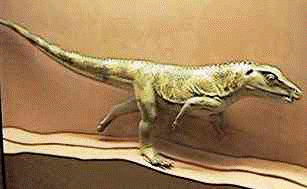 |
| Ornithosuchus
|
Thecodont in evolutionary systematics, (Romer, Carroll) an order of Triassic archosaurs, morphologically similar to each other, and ancestral to several later groups. Originally usually interpreted as mostly small bipedal forms. In cladistics, a paraphyletic assemblage of basal or stem archosaurs, which became a wastebasket taxon for any non-crocodilian, non-pterosaurian, non-dinosaurian archosaurs. It includes the includes the Triassic members of two different archosaurian clades, Ornithodira and Crurotarsi. On Palaeos used in lower case, rather than as a formal taxon.
Theistic evolution the view that some or all classical religious teachings about God and creation are compatible with some or all of modern scientific theory, including, specifically, evolution. Most adherents consider that the first chapters of Genesis should not be interpreted as a "literal" description, but rather as a literary framework or allegory. Theistic evolutionists have frequently been prominent in opposing creationism.
Thermoregulation the ability of an organism to keep its body temperature within certain boundaries, even when the surrounding temperature is very different. This process is one aspect of homeostasis: a dynamic state of stability between an animal's internal environment and its external environment. See also ectotherm, endotherm, gigantothermy.
Theropod derived from the Greek terms θηρός (thēros, "beast") and πόδα (poda, "foot"). Rather misleadingly named because these dinosaurs were distinguished by their bird-like appearance and, yes, bird-like feet. In fact, birds evolved from theropods (or in cladistic methodology birds are a derived clade of theropods). Theropods are one of the three main clades of dinosaurs, the other two being sauropodomorphs and ornithischians. They also include the only meat-eating dinosaurs (all other groups were herbivores). These diverse, impressive, and highly successful animals evolved into a number of small and large to gigantic types, as well as becoming increasingly more bird-like. During the Cretaceous, there was a spectrum of animals from primitive yet successful hold-overs like the abelisaurs, through allosaurs to advanced, feathered, and bird-like coelurosaurs, to true birds of several types. Well known types include Coelophysis, Allosaurus, Velociraptor, and Tyrannosaurus.
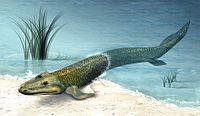 |
| Life restoration of Tiktaalik
|
Tiktaalik late Devonian animal transitional between sarcopterygian lobe-finned fish and tetrapod amphibians. The stout, fleshy pectoral fins have a joint corresponding to the elbow in higher tetrapods, and, unlike all other fish, there is a mobile neck and separate shoulder girdle.
Titanosaur large clade of medium-sized to gigantic Cretaceous sauropod dinosaurs, which included some of the largest animals that ever lived. Advanced forms, such as Saltasaurus, were medium-sized, with armour protection.
Topology in this context a technical term that refers to the particular shape or arrangement or branching order of the branches of a cladogram or phylogram
Trace fossil fossil not of an organism itself (e.g. shell, bone, mold, carbonised impression) but of the traces and impressions it left behind while alive (footprints, burrows, resting traces, etc. The study of trace fossils is called Ichnology.
Treatise on Invertebrate Paleontology massive multi-authored multi-authored work-in-progress (beginning 1953 and still ongoing), with contributions by more than 300 paleontologists, and covering every phylum, class, order, family, and genus of fossil and extant invertebrates.
Tree, phylogenetic tree a tree-like, diagrammatic representation of the evolutionary relationships and patterns of branching in the history of the organisms being considered. One type of tree, called a cladogram, is central to cladistics. Dendrogram can be used to refer either to a more informal diagram, or to one that emphasises phylogeny, speciation, time, etc .
Tree of Life poetic term for an evolutionary tree that (ideally) includes all life on Earth.
Triassic The earliest period of the Mesozoic era, spanning the time between 248 and 213 million years ago. The name Triassic refers to the threefold division of rocks of this age in Germany.
Archosaurs dominant on land as dinosaurs, in the oceans as ichthyosaurs and nothosaurs, and in the air as pterosaurs. Cynodonts become smaller and more mammal-like, while first mammals and crocodilians appear. Dicroidium flora common on land. Many large aquatic temnospondyl amphibians. Ceratitic ammonoids extremely common. Modern corals and teleost fish appear, as do many modern insect clades. Andean Orogeny in South America. Cimmerian Orogeny in Asia. Rangitata Orogeny begins in New Zealand. Hunter-Bowen Orogeny in Northern Australia, Queensland and New South Wales ends, (c. 260–225 Ma).
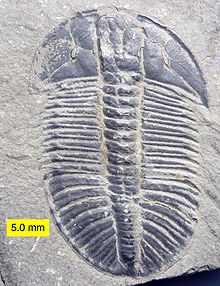 |
| Olenoides serratus from the Mt. Stephen Trilobite Beds (Middle Cambrian) near Field, British Columbia, Canada.
|
Trilobite important class of Paleozoic marine arthropods, distinguished by a three-fold division of the exoskeleton. Most were small (a few centimeters) although a few giants reached half a meter or so. Abundant during the Cambrian, where they make up the majority of invertebrate fossils. Also very common during the Ordovician to the Devonian, but declined thereafter. Their exquisite forms and great variety of species make them a favourite of most fossil collectors. Morphologically distinct; relationships with other arthropods unclear, hence included in a distinct subphylum, the Trilobitomorpha. Cambrian–Permian.
Tropical Referring to climatic conditions like those found in the region on the earth today between the tropic of Cancer and the tropic of Capricorn; it includes high temperature and humidity and abundant rainfall.
Tyrannosaurus rex elephant-sized theropod dinosaur from the latest Cretaceous, perhaps the best known superpredator of the Earth's past. More heavily built than other similar sized giant theropods. The last and largest representative of the family Tyrannosauridae, often (and often inaccurately) portrayed in popular culture (e.g. King Kong, Jurassic Park, etc). It is also the only prehistoric animal correctly represented by its binomial, rather than genus only.
Unconformity A buried erosion surface separating two rock masses.
Uniformitarianism Assumption that processes acting in the past are the same as those acting in the present. proposed the late 18th century theory of James Hutton that the natural forces now changing the shape of the earth's surface have been operating in the past much in the same way. The most important implication is that the earth is very old (deep time) and that the present is the key to understanding the past. Developed by Charles Lyell in the 19th century, who in turn influenced Darwin. Contrast with catastrophism, punctuated equilibrium.
Upper In geology, refers to the upper, and therefore younger or more recent strata. In the geological timescale, refers to the younger rocks of a period, especially when the period is divided into three; e.g. "Upper Jurassic". This usage is now generally replaced by the more chronological descriptive term Late.
Vendian The latest period of the Proterozoic era, spanning the time between 650 and 544 million years ago. Also referred to as the Ediacaran period, the Vendian is distinguished by fossils representing a characteristic collection of complex soft-bodied organisms found at several localities around the world.
After Vendian replaced Edicaran it seems the pendulum has now swung the other way, with Edicaran the preferred term for this period.
Vestigial, vestigial structure A non-functional anatomical component retained merely as a matter of contingent history.
Victorian age in Britain and the British colonies, the period of Queen Victoria's reign (from 1837 to 1901). A long and prosperous period, and also a time of great scientific, technological, and social advancement. Evolutionary thinking and the science of paleontology are among the developments that stem from this period (and also from equivalent contemporary developments in France, Germany, and the United States).
Vertebrate Notes the phylogenetic paleontology website developed by ATW, which formed the central element of Palaeos. As the name indicates, it is about Vertebrates, including many fossil forms. The Vertebrate Notes are currently been revised and upgraded, but all of the original material will be retained.
Vertebrates animals with backbones. Include all those large charismatic animals, as well as many smaller ones, that one often finds in popular books on prehistoric animals.
von Baer, Karl Ernst (1792–1876) Baltic German naturalist, a founding father of embryology, formulated what would later be called von Baer's laws, which refuted and replaced Haeckel's Recapitulation theory.
Wastebasket taxon a taxon that includes all species or groups that cannot be easily or conveniently placed elsewhere. e.g. for a while all large theropod dinosaurs that could not be included under the Ceratosauridae, Allosauridae or Tyrannosauridae were named "Megalosaurus".
Web of life conventionally refers to the food chain or trophic network, describes the feeding relationships between different species in an ecosystem. However, in reference to horizontal gene transfer can also refer to genetic transfer and evolution by non-hereditary means; especially common among bacteria.
Wegener, Alfred (1880–1930) A German climatologist and geophysicist whose book, The Origins of Continents and Oceans, was the first to propose the concept of continental drift (the forerunner to the theory of plate tectonics), as well as to suggest a supercontinent called Pangaea, which Wegener suggested had fragmented into the continents as we know them today. His ideas remained controversial until the 1960s, when they became widely accepted as new evidence led to the development of the concept of plate tectonics.
Woese, Carl Richard (b. 1928) American microbiologist and physicist who developed the three-domain system, based upon genetic relationships rather than obvious morphological similarities, with divided life into three domains: Bacteria, Archaea, and Eukarya.. His ideas and techniques, at first resisted by many, now form the basis of much of our understanding of the relationship of life on Earth.
Young Earth creationism the belief that the Earth along with the entire cosmos was created by a supernatural God within the last 10,000 years, or even 6000 or so years ago, as described literally in Genesis. The most common form of creationism.
Zallinger, Rudolph F. (1919–1995) Russian-born American paleo artist, notable for two immensely influential representations of evolution: the The Age of Reptiles mural (1947) (his The Age of Mammals follows a similar theme) and the popular illustration known as March of Progress (1965), one of the world's most recognizable scientific images.
Zygote The cell formed by the fertilization of male and female gametes.
A | B | C | D | E | F | G | H | I | J | K | L | M | N | O | P | Q | R | S | T | U | V | W | X | Y | Z





























